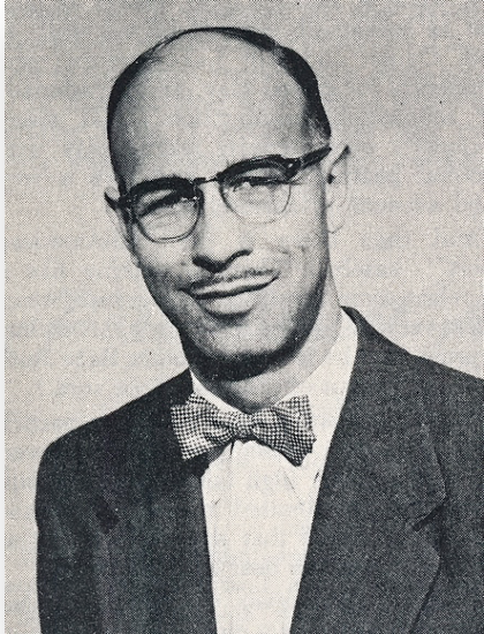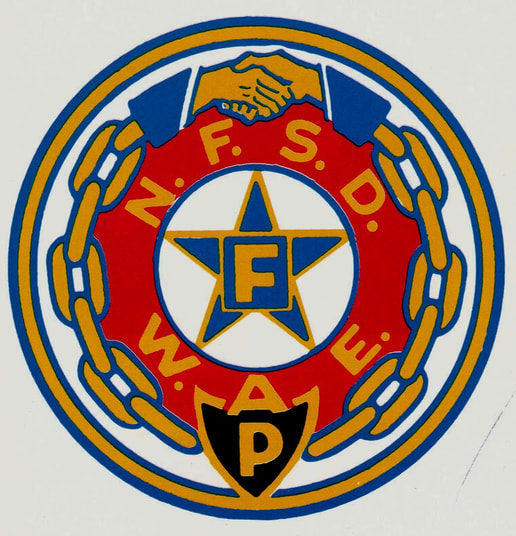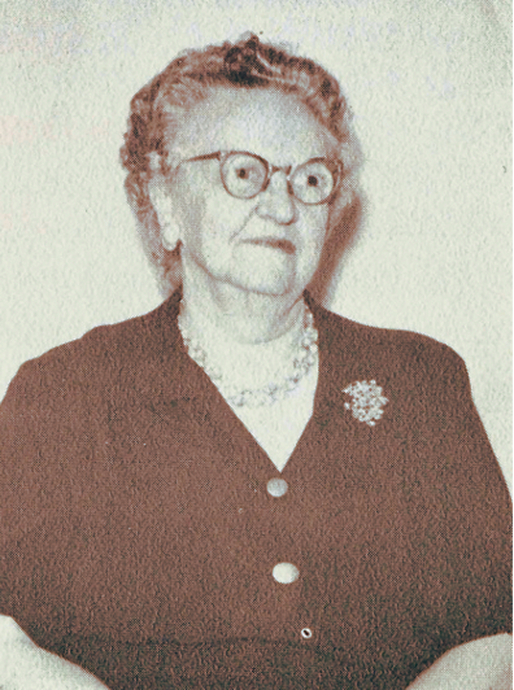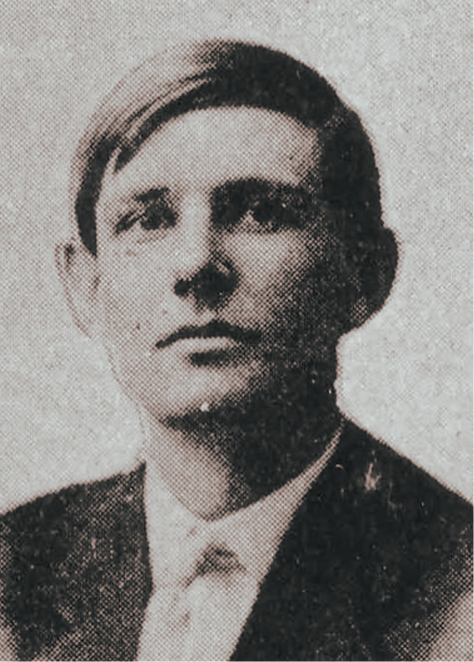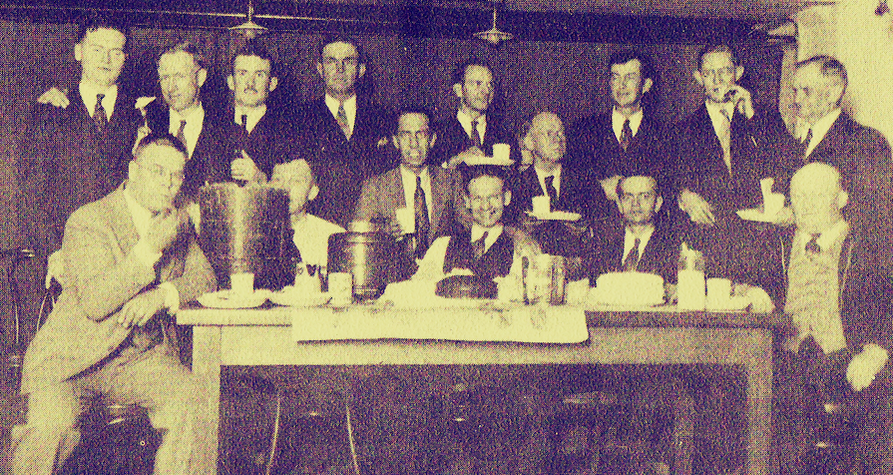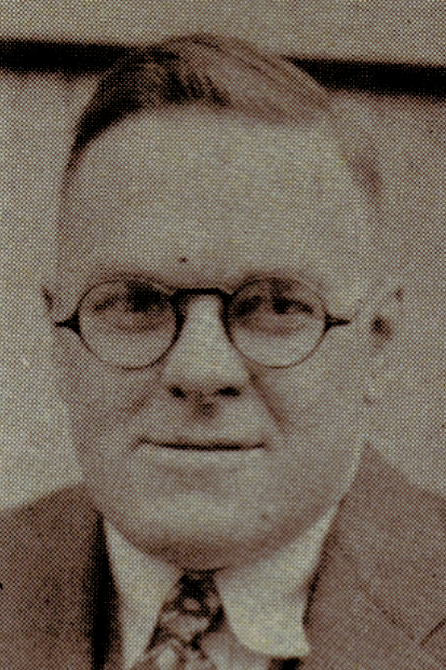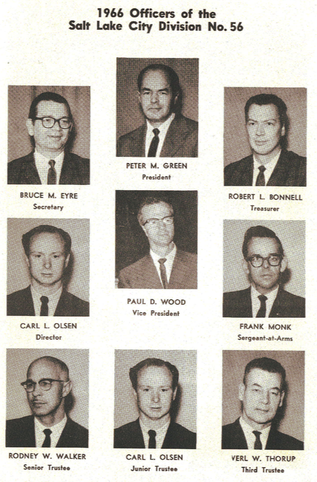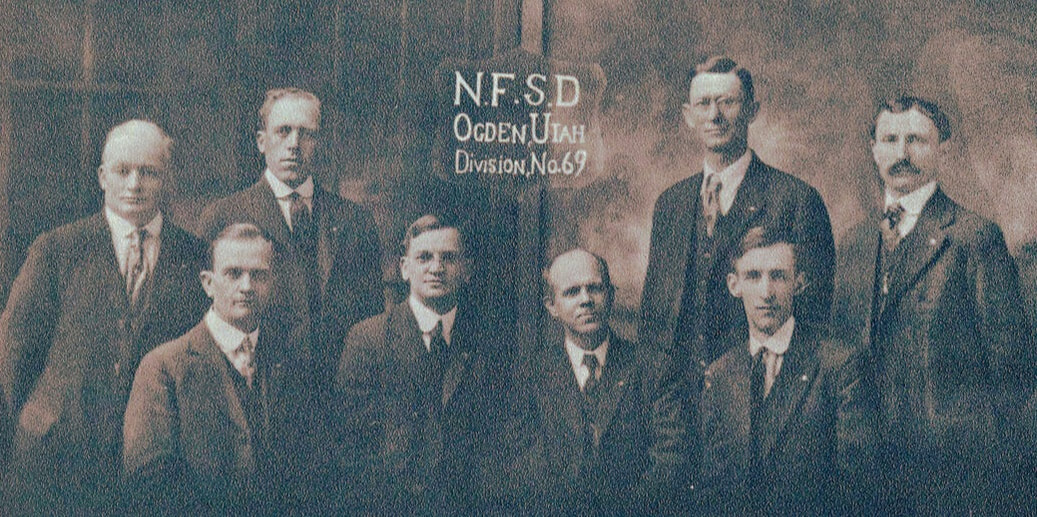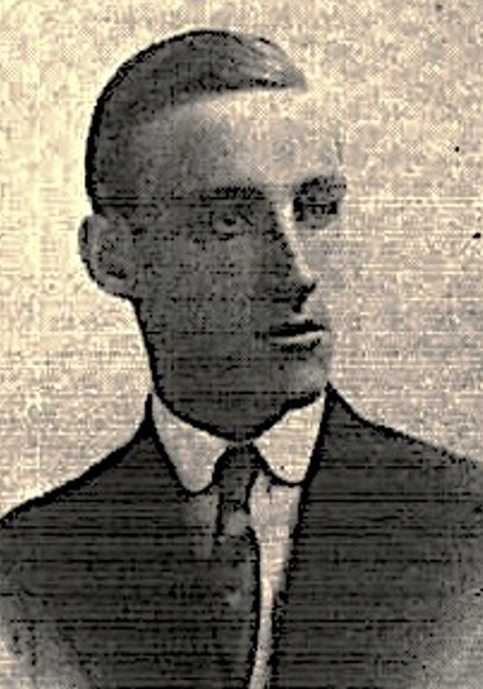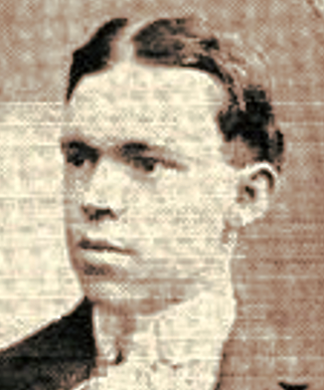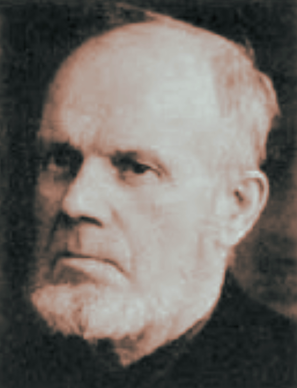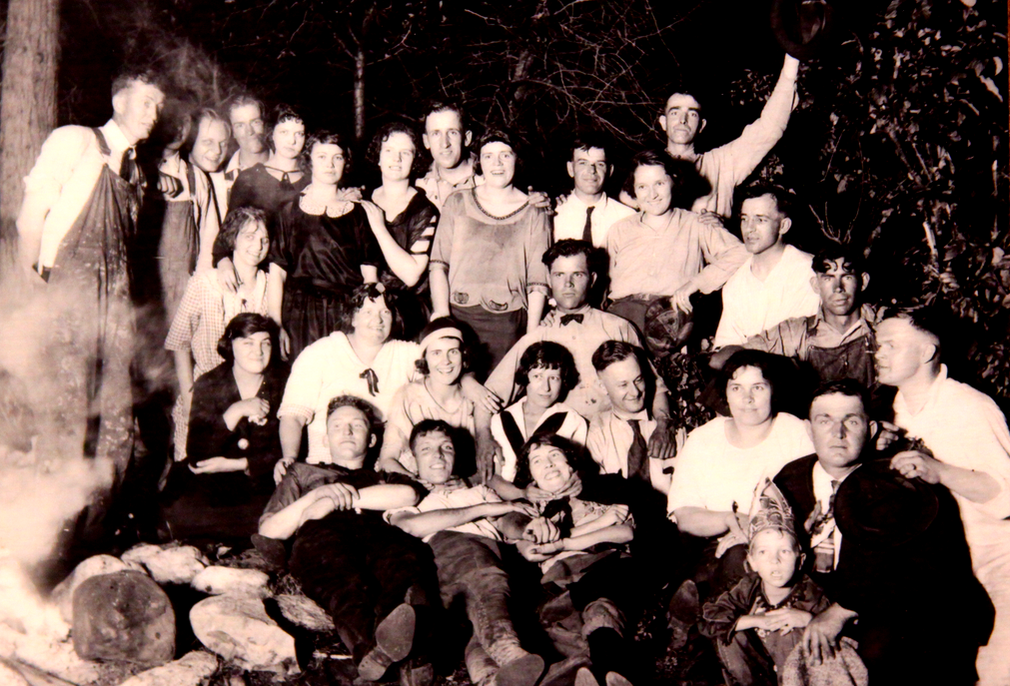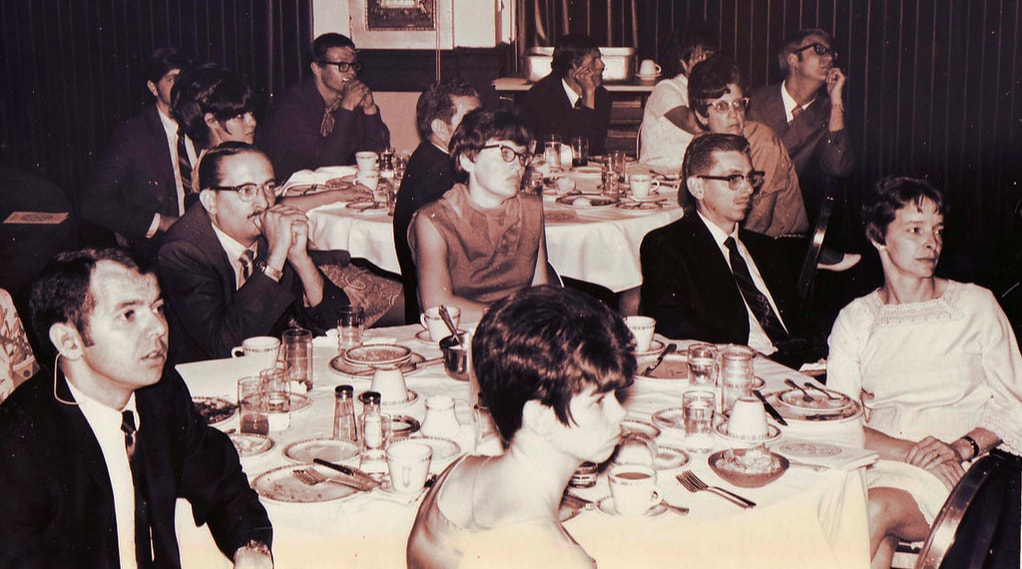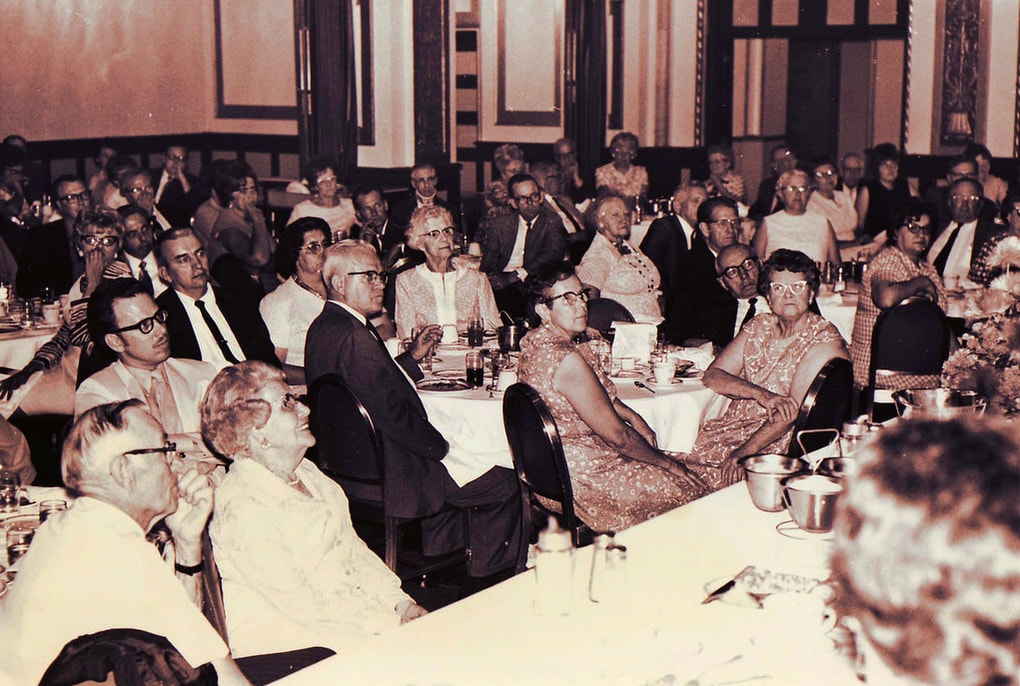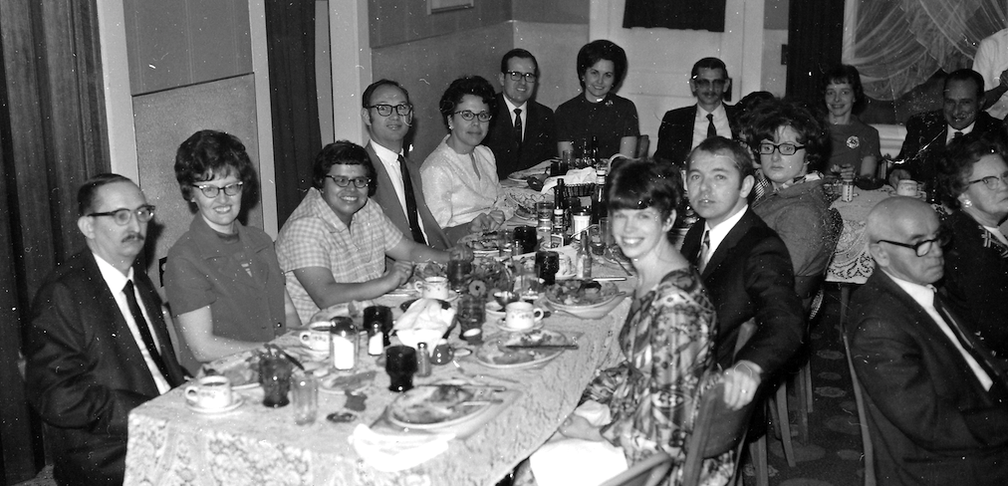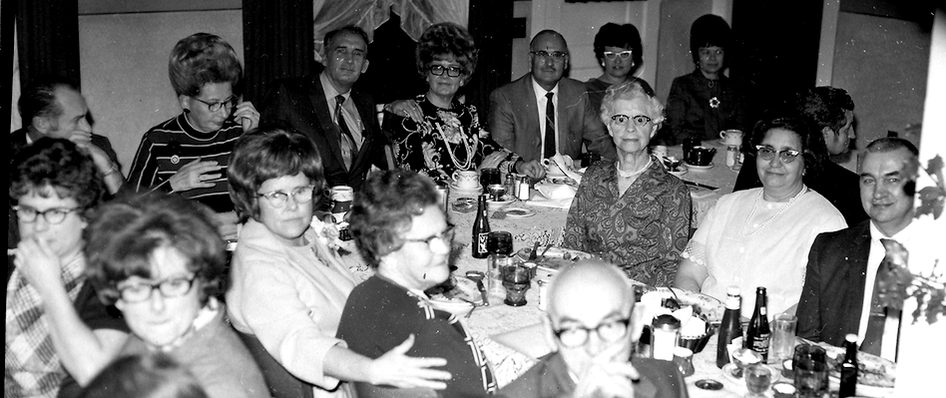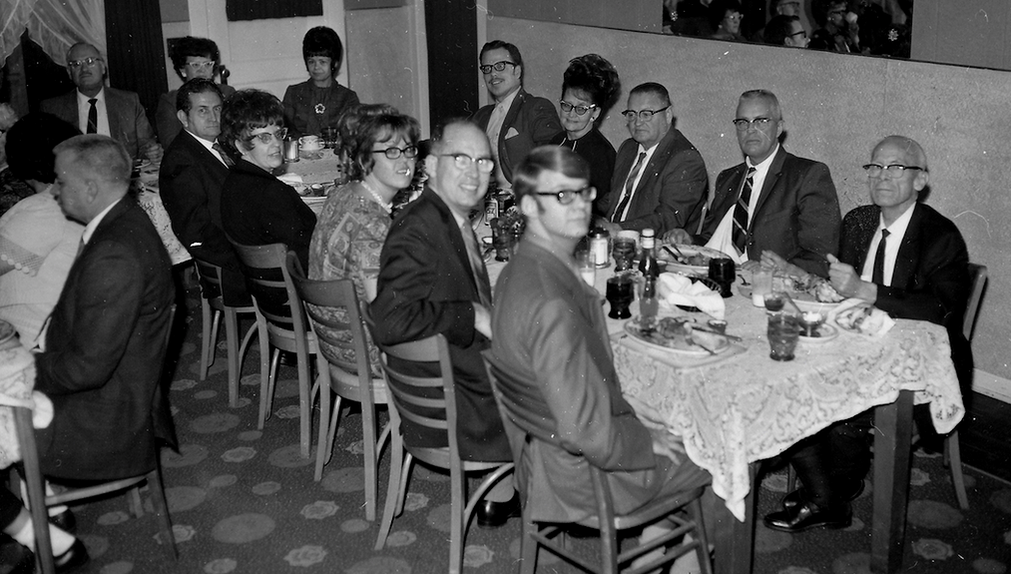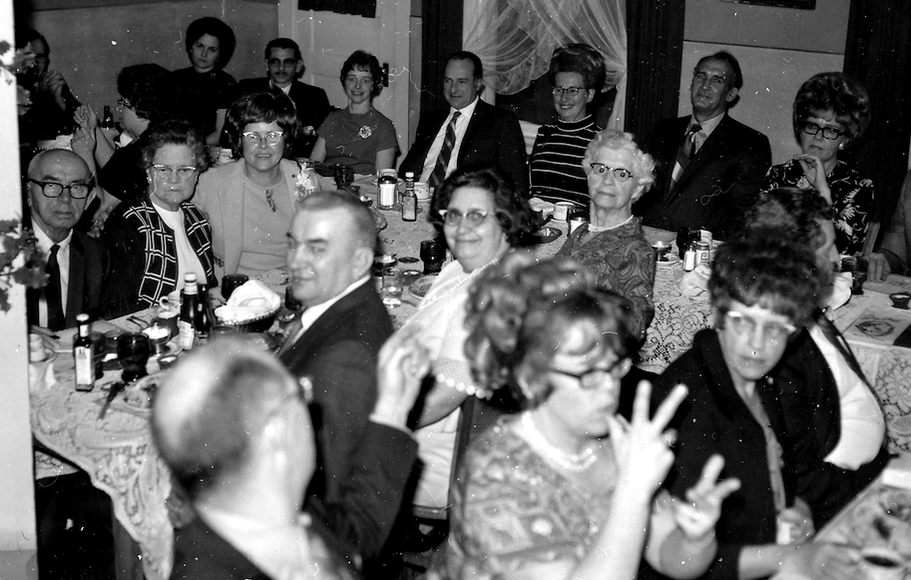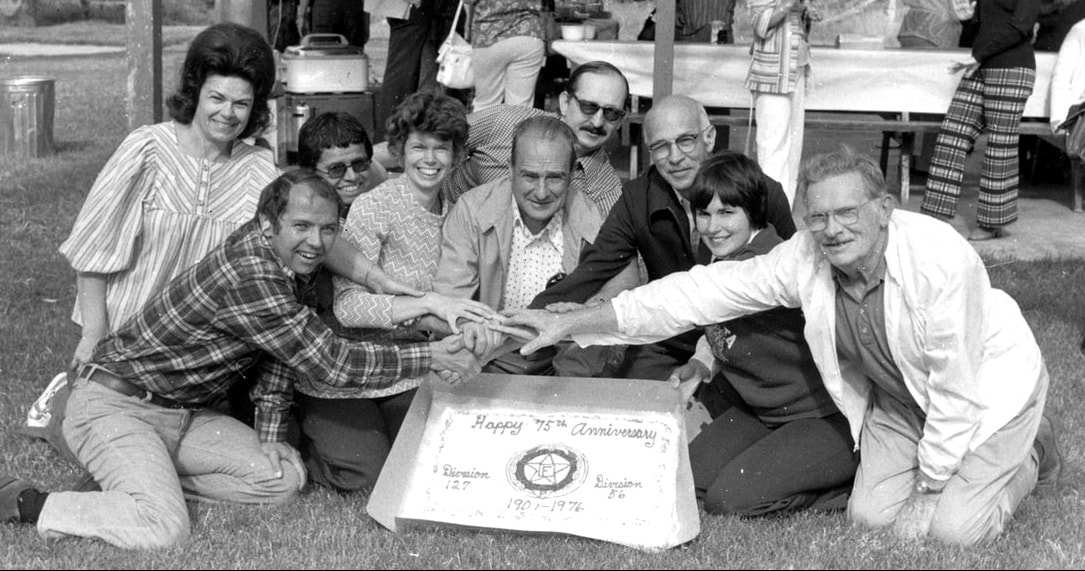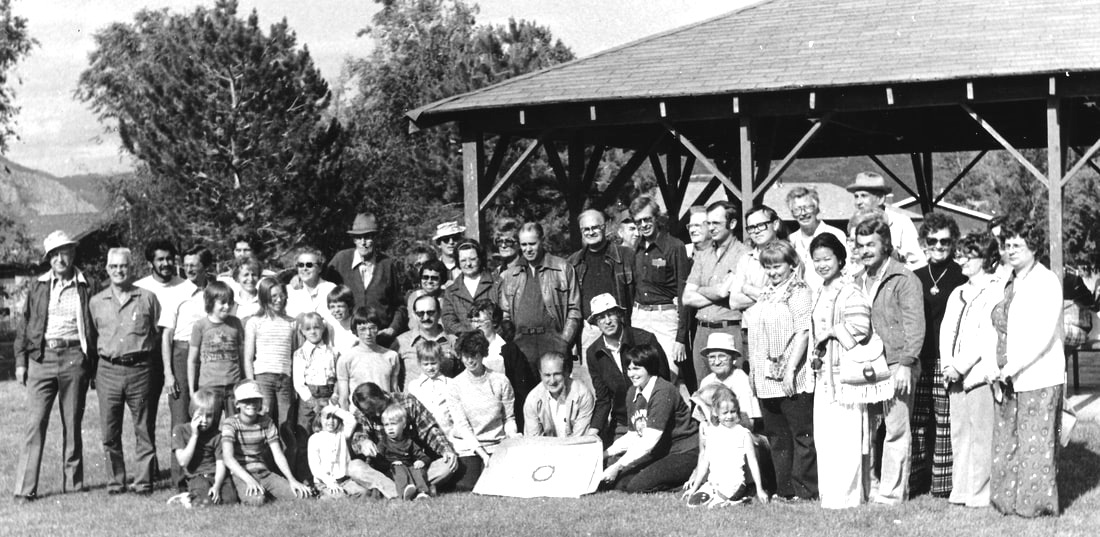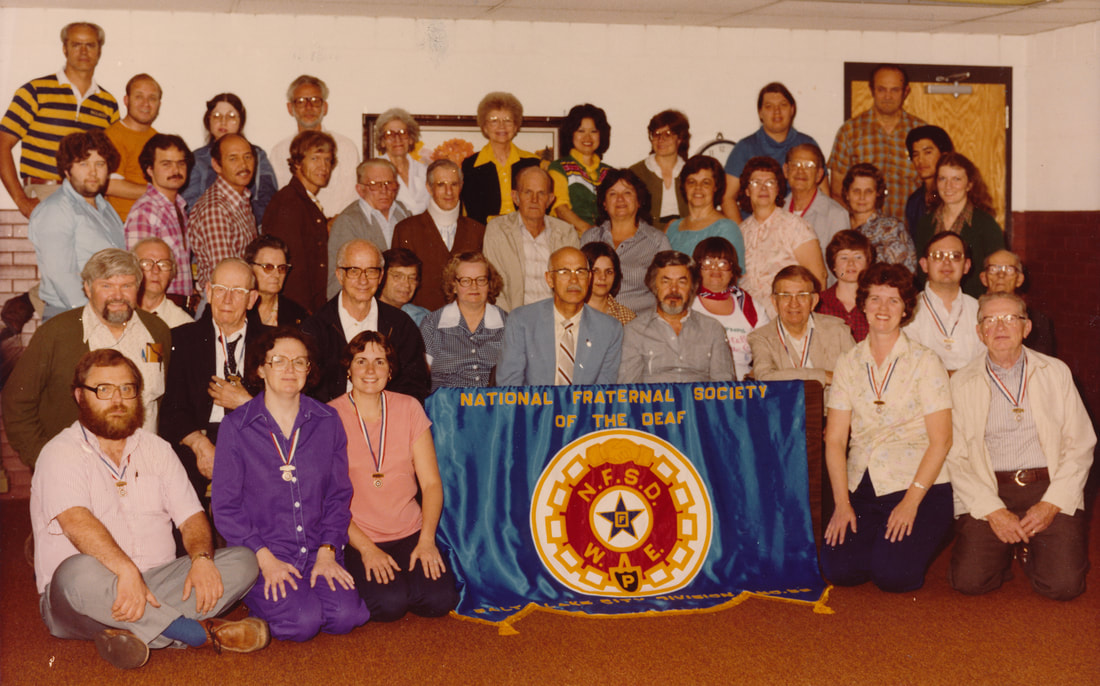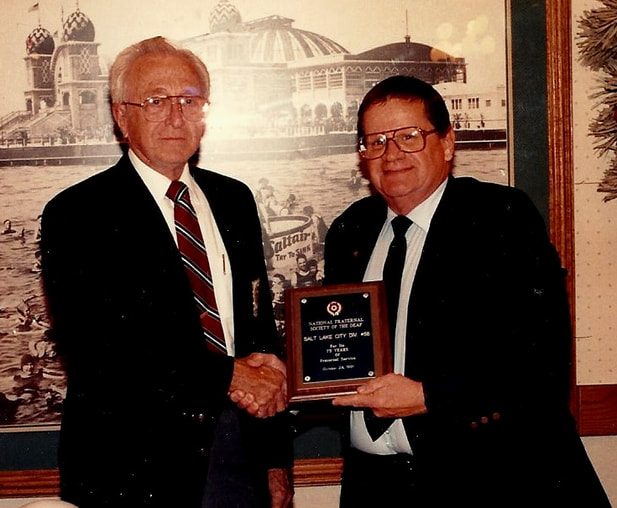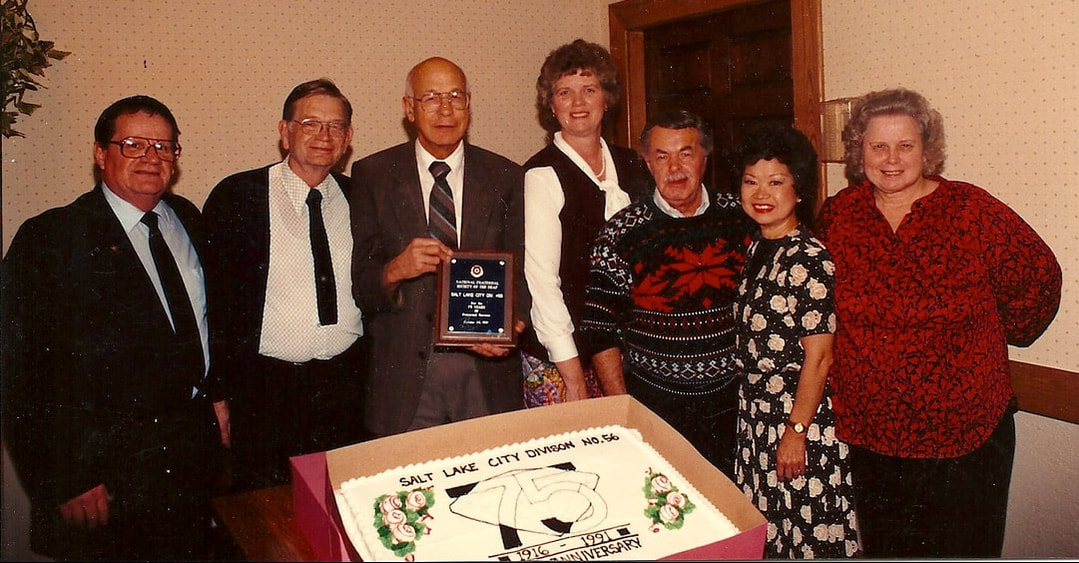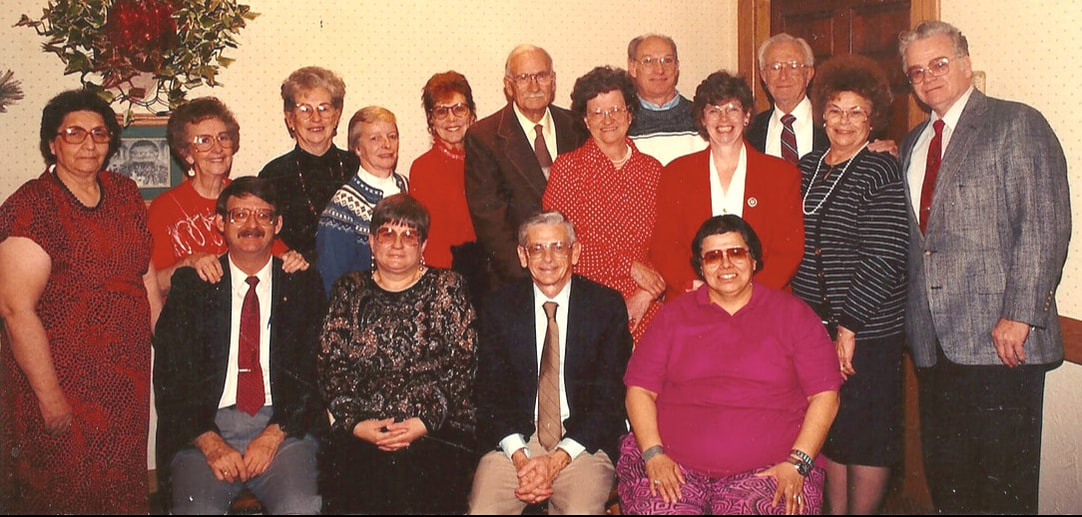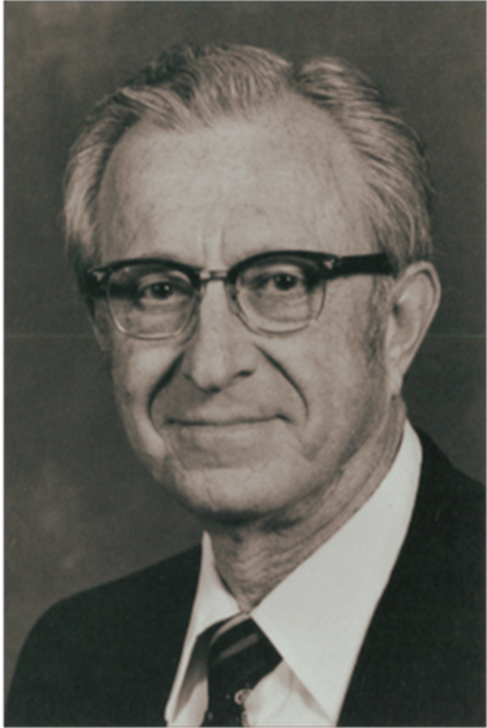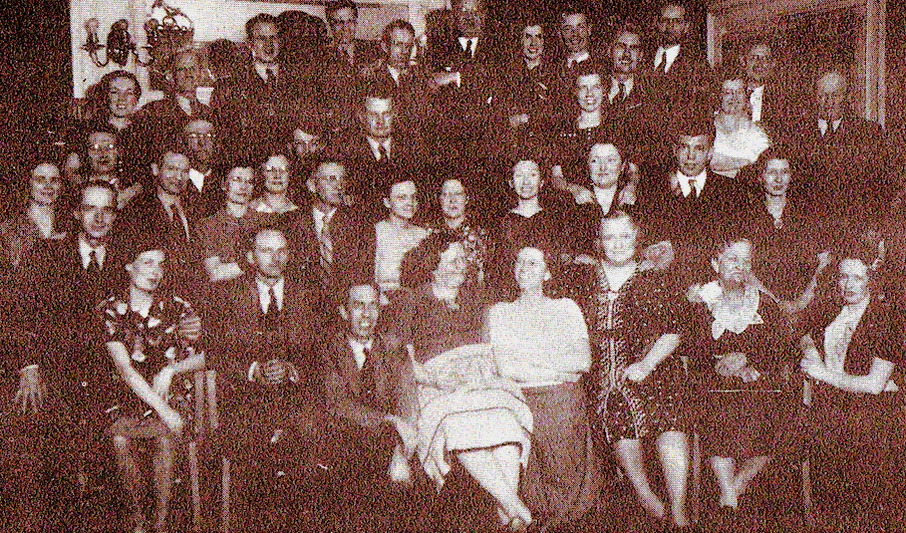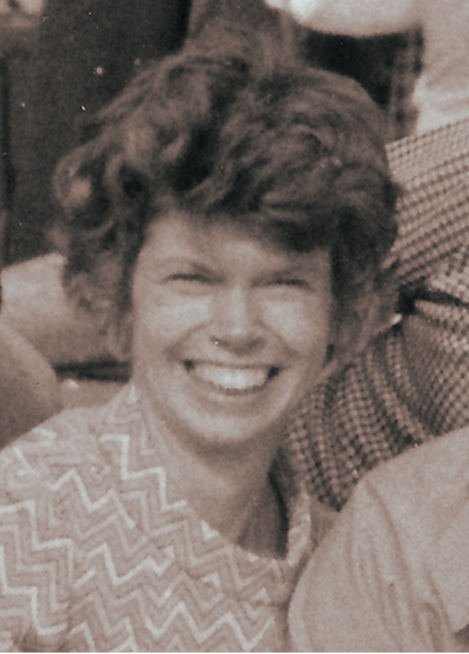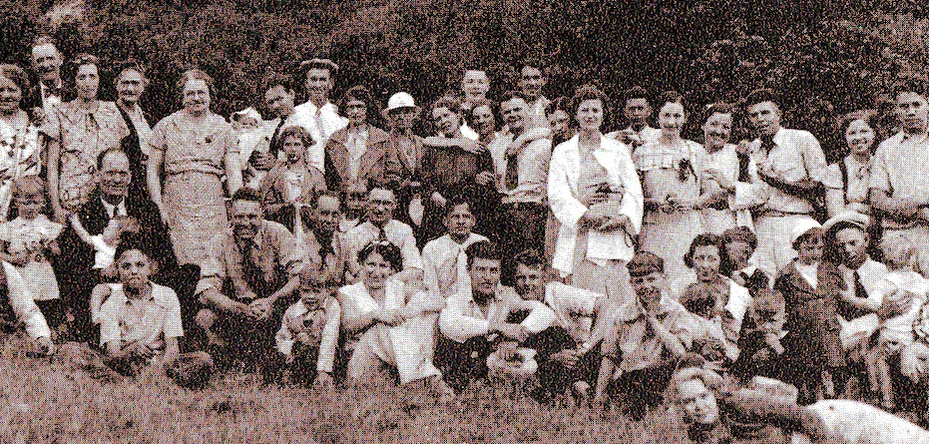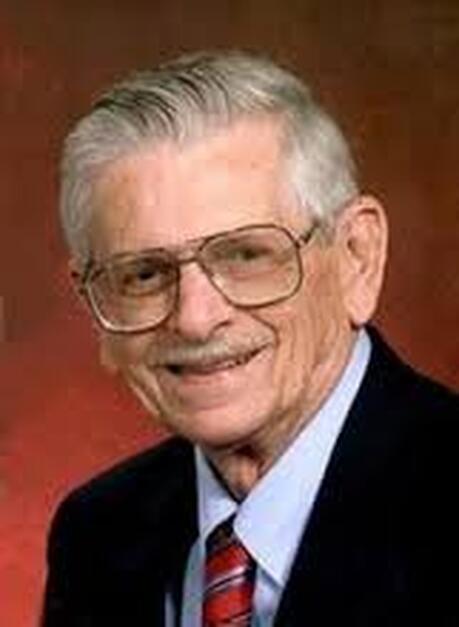History of the National Fraternal
Society of the Deaf
Compiled & Written by Jodi Becker Kinner
Published in 2012
Updated in 2024
Published in 2012
Updated in 2024
Author's Note
Established in 1901, the National Fraternal Society of the Deaf aimed to provide insurance coverage to Deaf people, a service that regular insurance companies refused to provide. This webpage describes the process of establishing its insurance business, the benefits of its coverage to the Deaf community, the formation of community connections, and its final closure due to insurance availabilities for the Deaf community.
When writing about individuals for our history website, I choose to use their first name to acknowledge all individuals who contribute to and advocate for our community's causes. Our patriarchal culture often expects to recognize women's advocacy, contributions, and achievements using their husbands' last names instead of their own. However, in the spirit of inclusivity, equality, and recognizing each individual's unique identity, I have decided to use their first names throughout the website. This decision reaffirms our commitment to these values and highlights the significant role of women's advocacy in our community.
I appreciate your interest in reading this 'History of the National Fraternal Society of the Deaf' webpage. Fortunately, We have insurance available today, which they battled for in the past.
Enjoy!
Jodi Becker Kinner
When writing about individuals for our history website, I choose to use their first name to acknowledge all individuals who contribute to and advocate for our community's causes. Our patriarchal culture often expects to recognize women's advocacy, contributions, and achievements using their husbands' last names instead of their own. However, in the spirit of inclusivity, equality, and recognizing each individual's unique identity, I have decided to use their first names throughout the website. This decision reaffirms our commitment to these values and highlights the significant role of women's advocacy in our community.
I appreciate your interest in reading this 'History of the National Fraternal Society of the Deaf' webpage. Fortunately, We have insurance available today, which they battled for in the past.
Enjoy!
Jodi Becker Kinner
Acknowledgement
I would like to express my gratitude to Valerie G. Kinney for her invaluable assistance in preparing this document by offering consultation directions.
I am also grateful to Eleanor McCowan for suggesting I work on the Utah Deaf History project. None of this would have been possible without her.
Special credit goes to Rodney W. Walker for compiling, documenting, and preserving the history of the Salt Lake City Division No. 56 and the Ogden Division No. 127 in Utah.
Lastly, I want to thank my spouse, Duane Kinner, and my children, Joshua and Danielle, for their support and patience throughout the completion of this project.
Jodi Becker Kinner
I am also grateful to Eleanor McCowan for suggesting I work on the Utah Deaf History project. None of this would have been possible without her.
Special credit goes to Rodney W. Walker for compiling, documenting, and preserving the history of the Salt Lake City Division No. 56 and the Ogden Division No. 127 in Utah.
Lastly, I want to thank my spouse, Duane Kinner, and my children, Joshua and Danielle, for their support and patience throughout the completion of this project.
Jodi Becker Kinner
The Establishment of the
Fraternal Society of the Deaf
Fraternal Society of the Deaf
The Michigan School for the Deaf (MSD) in Flint, Michigan, proposed creating a fraternal club in 1898. Creating fraternal groups in the United States was very popular at the time. Up to 70,000 men formed fraternal societies, and hundreds of thousands of men joined them (Borggaard, 2001).
The MSD students were part of the Coming Men of America (CMA) junior fraternal organization, McKinley Lodge No. 922. The CMA was an organization that focused on developing leadership skills. The CMA aimed to teach young men about patriotism, honor, and manhood (Walker, 1966; Gannon, 1981; Borggaard, 2001). In the summer of 1898, thirteen young male graduates of the Michigan School for the Deaf and members of the CMA's McKinley Lodge No. 922 met on the MSD campus to discuss providing insurance protection for themselves and other Deaf men. The CMA's objectives motivated them, and they were concerned about the difficulty Deaf people faced in obtaining life, death, and accident insurance (Borggaard, 2001; Walker, 2006).
At the time, insurance companies and fraternal benefit societies often denied Deaf people the ability to buy insurance coverage, under the impression that Deaf individuals were more likely to be involved in accidents and had shorter life spans than the general population. As a result, Deaf men were either overcharged or denied coverage. The group of young Deaf men wanted the same rights as hearing individuals (Gannon, 1981; The UAD Bulletin, Summer 1966).
After experiencing discrimination in insurance coverage and jobs, the organizing group came up with the idea of the Fraternal Society of the Deaf (Borggaard, 2001). Peter N. Hellers Jr., of Detroit, Michigan, was elected president of the organizing group, and he and other officials were tasked with investigating the possibility of founding a fraternal insurance group and reporting to the members at the next MSD reunion. Over the next three years, the president and officials spent many hours researching and acquiring insurance information. Finally, they were prepared to take action at the second meeting (Gannon, 1981).
The MSD students were part of the Coming Men of America (CMA) junior fraternal organization, McKinley Lodge No. 922. The CMA was an organization that focused on developing leadership skills. The CMA aimed to teach young men about patriotism, honor, and manhood (Walker, 1966; Gannon, 1981; Borggaard, 2001). In the summer of 1898, thirteen young male graduates of the Michigan School for the Deaf and members of the CMA's McKinley Lodge No. 922 met on the MSD campus to discuss providing insurance protection for themselves and other Deaf men. The CMA's objectives motivated them, and they were concerned about the difficulty Deaf people faced in obtaining life, death, and accident insurance (Borggaard, 2001; Walker, 2006).
At the time, insurance companies and fraternal benefit societies often denied Deaf people the ability to buy insurance coverage, under the impression that Deaf individuals were more likely to be involved in accidents and had shorter life spans than the general population. As a result, Deaf men were either overcharged or denied coverage. The group of young Deaf men wanted the same rights as hearing individuals (Gannon, 1981; The UAD Bulletin, Summer 1966).
After experiencing discrimination in insurance coverage and jobs, the organizing group came up with the idea of the Fraternal Society of the Deaf (Borggaard, 2001). Peter N. Hellers Jr., of Detroit, Michigan, was elected president of the organizing group, and he and other officials were tasked with investigating the possibility of founding a fraternal insurance group and reporting to the members at the next MSD reunion. Over the next three years, the president and officials spent many hours researching and acquiring insurance information. Finally, they were prepared to take action at the second meeting (Gannon, 1981).
After years of preparation and planning, the founding members founded the Fraternal Society of the Deaf on June 12, 1901. During their next reunion on the MSD campus, the members requested a lodge meeting to elect new board officers. They presented Certificate No. 1 to Peter N. Hellers Jr., the first grand president (Gannon, 1981; Borggaard, 2001). After two months, on August 12, 1901, Illinois law officially recognized the Fraternal Society as a non-profit group. The board chose to open the company's first office in Chicago, Illinois, since most of its members worked in the area (Gannon, 1981).
The early years were challenging for the officers, as they lacked funds for an office and had little to no experience running a fraternal insurance company. However, they persevered and worked tirelessly to achieve their goals. Despite its small size, the Fraternal Society faced the hurdle of insufficient funds to cover the funeral benefits it had established. To address this, each member donated a one-dollar gift to help pay for the funeral costs of every member who died. This arrangement was complicated for members who lived longer, but it was common practice for fraternal insurance groups to do it (Gannon, 1981).
As time passed, the Fraternal Society became more widely recognized, and its benefits improved by adding life, illness, and accident insurance. The first official office opened in Chicago, Illinois, in 1905, and the Fraternal Society has grown to 200 members and eight divisions. The Fraternal Society's success in those early years was a credit to the pioneering efforts of the men who kept the fraternal society alive and flourishing through their faith, perseverance, and hard work (Gannon, 1981).
The early years were challenging for the officers, as they lacked funds for an office and had little to no experience running a fraternal insurance company. However, they persevered and worked tirelessly to achieve their goals. Despite its small size, the Fraternal Society faced the hurdle of insufficient funds to cover the funeral benefits it had established. To address this, each member donated a one-dollar gift to help pay for the funeral costs of every member who died. This arrangement was complicated for members who lived longer, but it was common practice for fraternal insurance groups to do it (Gannon, 1981).
As time passed, the Fraternal Society became more widely recognized, and its benefits improved by adding life, illness, and accident insurance. The first official office opened in Chicago, Illinois, in 1905, and the Fraternal Society has grown to 200 members and eight divisions. The Fraternal Society's success in those early years was a credit to the pioneering efforts of the men who kept the fraternal society alive and flourishing through their faith, perseverance, and hard work (Gannon, 1981).
The Establishment of the
National Fraternal Society of the Deaf
National Fraternal Society of the Deaf
On December 2, 1907, the society underwent a transformative change, adopting the name National Fraternal Society of the Deaf (NFSD). It was incorporated as a legal reserve society in Illinois, allowing it to operate as a fraternal beneficiary society. The establishment of the National Fraternal Insurance Society of the Deaf was a pivotal institution in the United States. In 1966, the society's philosophy was one of familial unity, with members addressing each other as brothers and sisters (Walker, 2006).
The National Fraternal Society of the Deaf Denies
Deaf Women Full Membership and Admission
Deaf Women Full Membership and Admission
Despite being initially excluded, the National Fraternal Society of the Deaf did not offer women the same privileges as men, including regular insurance membership. In order to enjoy all the rights and benefits granted to men, women had to fight for their rights. In the early 1915, there was a remarkable turn of events as Deaf women, undeterred by the men running the organization, started to demand full membership and admission to the NFSD. Their persistence in the face of refusal from the heads of their households at the time is truly inspiring. Despite numerous setbacks, women persevered in their efforts. In 1937, the NFSD allowed them to form social auxiliaries to promote the interests of their designated division, which was a minor step towards equality. Yet, the NFSD still denied women full entry until the 1951 NFSD Conference, finally giving them the right to become regular insurance members (Records of the National Fraternal Society of the Deaf, 1900–2006). Women who never married may have been unable to join the organization or obtain insurance.
In a sign of progress, the NFSD lifted the race restriction in 1955, allowing the Black Deaf community to become members. This was a significant step towards inclusivity. Another change occurred in 1967 when the organization extended membership to hearing children of Deaf members, demonstrating its evolving inclusivity. Although these changes took time, they indicated a promising future for the NFSD and its commitment to inclusivity (Walker, 2006).
In a sign of progress, the NFSD lifted the race restriction in 1955, allowing the Black Deaf community to become members. This was a significant step towards inclusivity. Another change occurred in 1967 when the organization extended membership to hearing children of Deaf members, demonstrating its evolving inclusivity. Although these changes took time, they indicated a promising future for the NFSD and its commitment to inclusivity (Walker, 2006).
Here are a couple of facts about the
National Fraternal Society of the Deaf:
National Fraternal Society of the Deaf:
- Officers of the NFSD must be deaf, which has been a requirement since the organization's inception.
- In 1975, the NFSD relocated to its home in Mt. Prospect, Illinois.
- In 1978, the NFSD issued its 30,000th Life Insurance Certificate.
- In 1981, the NFSD's assets reached $8 million (Walker, 2006)
The Establishment of the
Salt Lake City Division No. 56
Salt Lake City Division No. 56
Following its establishment in 1901, the National Fraternal Society of the Deaf rapidly expanded across the United States, setting up divisions in various cities. This significant growth enabled the NFSD to reach and serve a larger Deaf community, offering them insurance and other benefits. Notably, Salt Lake City Division No. 56 was one of these divisions, and it owes its existence to the pioneering efforts of Justina Wooldridge Keeley. Her discovery of a new insurance organization owned and run by Deaf people was not just a catalyst but a significant contribution to the division's formation.
Justina, a pivotal figure in the history of the National Fraternal Society of the Deaf, later joined the Salt Lake City Division No. 56. She discovered NFSD, an insurance organization owned and operated by Deaf individuals, during a visit to Missouri, which was a turning point for her. After returning to Salt Lake City, Utah, she shared the news and inspired others, including Melville John Matheis, a Deaf resident of Utah. Intrigued by the organization, he made a personal journey to Chicago to gain a deeper understanding of its operations. Impressed by what he saw, he became an NFSD member on August 1, 1916. The Salt Lake City Division No. 56 was established on October 24, 1916, by eight men with the assistance of Grand Secretary-Treasurer Francis P. Gibson (UAD Bulletin, Summer, 1966; Walker, 1966). Justina's discovery was bittersweet because, for 35 years, the NFSD denied women, including Justina, full membership and admission to the NFSD. In 1951, at the convention in Chicago, Illinois, the NFSD made a historic decision to grant women regular insurance membership and admission. This decision was a significant milestone in the organization's history, emphasizing the importance of gender inclusion in NFSD (Records of the National Fraternal Society of the Deaf, 1900–2006).
Justina, a pivotal figure in the history of the National Fraternal Society of the Deaf, later joined the Salt Lake City Division No. 56. She discovered NFSD, an insurance organization owned and operated by Deaf individuals, during a visit to Missouri, which was a turning point for her. After returning to Salt Lake City, Utah, she shared the news and inspired others, including Melville John Matheis, a Deaf resident of Utah. Intrigued by the organization, he made a personal journey to Chicago to gain a deeper understanding of its operations. Impressed by what he saw, he became an NFSD member on August 1, 1916. The Salt Lake City Division No. 56 was established on October 24, 1916, by eight men with the assistance of Grand Secretary-Treasurer Francis P. Gibson (UAD Bulletin, Summer, 1966; Walker, 1966). Justina's discovery was bittersweet because, for 35 years, the NFSD denied women, including Justina, full membership and admission to the NFSD. In 1951, at the convention in Chicago, Illinois, the NFSD made a historic decision to grant women regular insurance membership and admission. This decision was a significant milestone in the organization's history, emphasizing the importance of gender inclusion in NFSD (Records of the National Fraternal Society of the Deaf, 1900–2006).
The Salt Lake City Division No. 56 was founded by Melville J. Matheis, Alfred C. Keeley, Joseph G. Keeley, John Wallace McMills, Leo Hawkins, Emery E. Preece, Lyman Bernstein, and Jacob Beck (UAD Bulletin, Summer, 1966). In 1916, the organization grew by eight people before the end of the year. The division welcomed thirteen additional members the following year, and again thirteen more in 1918. The total number of members only took three years to reach around forty-two individuals (Walker, 1966; Walker, 2006).
A few Society members left after believing that the meetings were exclusively open to division members and referring to the division as a "secret society" some years later. As soon as the misunderstanding was settled, the negative label was removed, and the number of members began to grow again, and the membership increased (Walker, 2006).
A few Society members left after believing that the meetings were exclusively open to division members and referring to the division as a "secret society" some years later. As soon as the misunderstanding was settled, the negative label was removed, and the number of members began to grow again, and the membership increased (Walker, 2006).
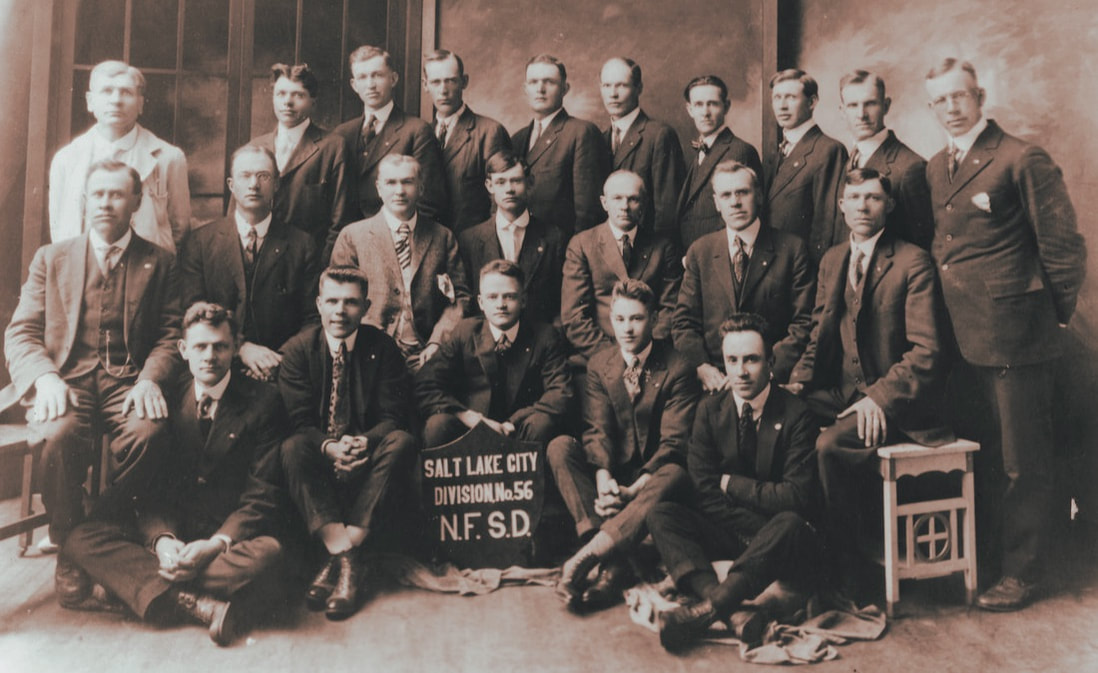
Members of the Salt Lake City Division No. 56, 1918
Front Row (L-R): John McMills, Grant Morgan, Earl Lewis, Jack Waterhouse, Alma Wild. Middle Row (L-R): Ezra Christensen, Joseph Cameron, John Rowan, Riley Carter, Jacob Beck, Axel Amundsen, Ole Pettit. Back Row (L-R): Michael Rowan, Dallas Burros, George Preece, Robert Hicks, Emery Preece, Ezra Rollo, LeRoy Donelson, Alexander Wright, Leo Harkins, Elign Jacobsen. In courtesy of J Willard Marriott Library
The Salt Lake Frats in a
Parade in About 1918
Parade in About 1918
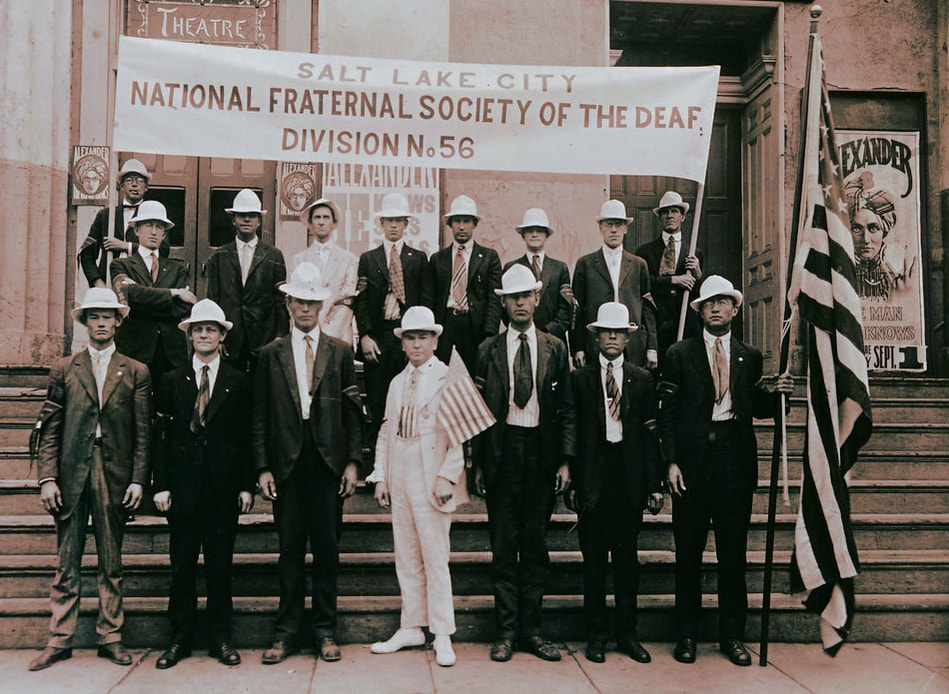
Salt Lake Frats in a parade in about 1918. Front Row (L-R): Riley Carter, John McMills, Ezra Rollo, Michael Rowan (holding flag), Robert Hicks, Ole Pettit, Joseph Cameron. Second Row (L-R): George Precce, Dallas Burrows, Leroy Donelson, Floyd Underwood, Alex Wright, Earl Lewis, Axel Anderson. Third Row (L-R): Elgin Jacobsen and Lee Hawkins (holding the banner). In courtesy of J Willard Marriott Library
The Salt Lake City Division No. 56
Conducts a Banquet
Conducts a Banquet
On February 21, 1920, the Salt Lake City Division No. 56 hosted a banquet at the Newhouse Hotel to celebrate President George Washington's birthday. Around sixty people attended this event, including Harry Sanger Smith, who wrote for The Silent Worker, a Deaf publication named "Bob White." Harry had a delightful evening, as he later described in The Silent Worker magazine's April 1920 issue (White, The Silent Worker, April 1920).
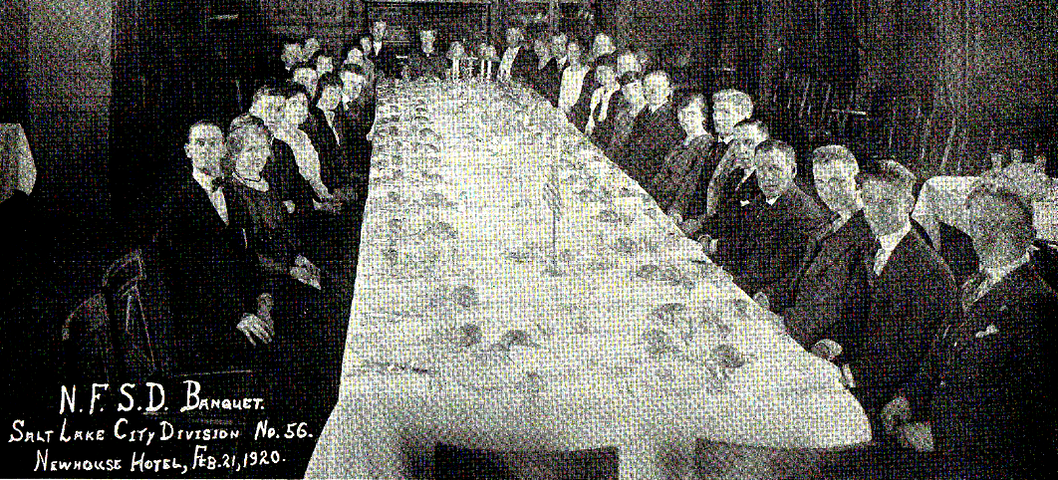
Members of the Salt Lake City Division No. 56. L-R: Roy Donelson, F lorenceY. oung, Geor .ge Preece.E lsie Preece, EmeryP reece,E velynF ehr, John Fehr, Ha i Wriqhf , Alex Wright ,
, : - - - - - - , - - - - - - . Mary Woolslayer , Pear l Jacobsen, Elgin Jacobsen, Mrs. Rowan, John Rowan, Mildred Amundsen, Axel Amundsen, Hannah
Cameron, Joseph Cameron, Amy Hawlins, Leo Hawkins, Lucille Elben, Slanley Brodie, Alice Vicls, Michael Rowan, Alma *ild, E r" Chrislensen, Kennelh Murphy, Jack Waterhouse, Floyd Underwood
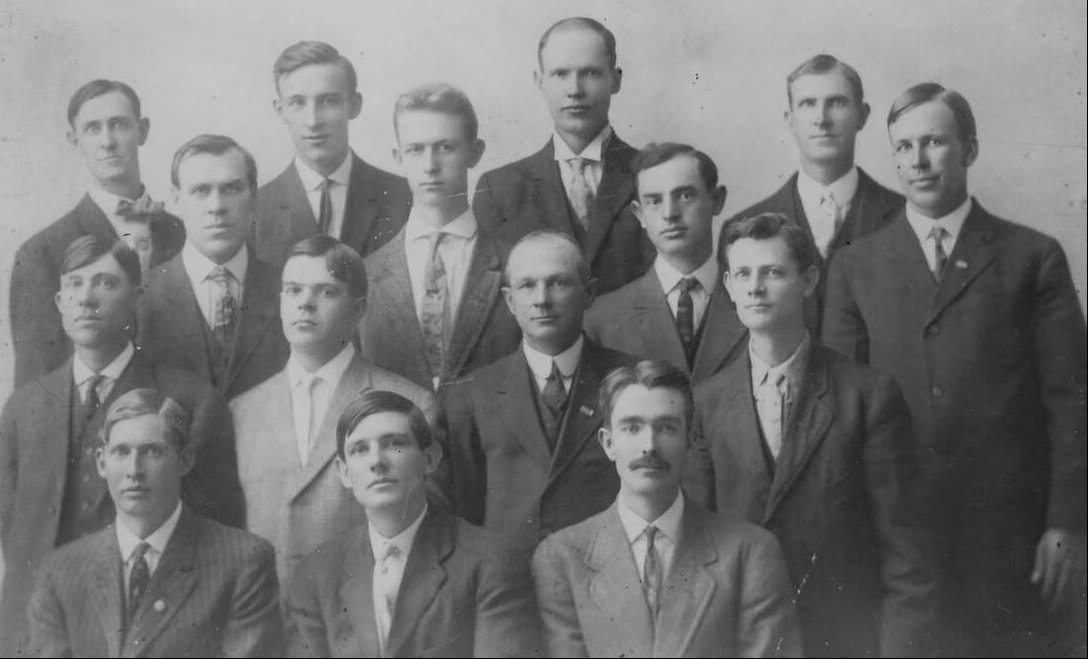
Members of the Salt Lake Division No. 56, 1921. Front Row (L-R): Alexander White, Melville Matheis, Rufus Briggs. Second Row (L-R): Ole Pettit, Joseph Keeley, Jacob Beck, John McMills. Third Row (L-R): Asel Amundsen, Leo White, Lyman Bernstein, Elgin Jacobsen. Back Row (L-R): Leroy Donelson, Otto Farley, Ezra Rollo, Leo Hawkins. In courtesy of J Willard Marriott Library
During the early 1900s, the "Frats" in Utah were responsible for organizing and managing various social events and activities. These events included games, refreshments, dances, trips, banquets, celebrations, and carnivals for members and non-members alike. According to the UAD Bulletin in the fall of 1961, fraternities played a significant role in directing society's activities. As a result, during that time, the Frats became an integral part of Utah's social fabric (Walker, 1966).
The monthly meetings were highly encouraged, and members were expected to attend. If a member missed a meeting without a valid reason, they would face a ten-cent fine. On the other hand, if members attended the meetings but failed to present their receipts as proof of payment of dues and good standing, they would also be fined ten cents. The meetings were so popular that they often had a high attendance and were sometimes overcrowded (Walker, 1966).
Members of the division can study Robert's Rules of Order to learn how to run meetings and serve in various capacities, such as officers, trustees, chairpersons, delegates, and so on. Through these experiences, members can earn merits, which would classify them as first-degree, tenth-degree, and so on, up to the thirty-fourth degree. For instance, Rodney W. Walker, a member of the Salt Lake City Division No. 56, was one of the ten members who achieved the 34th degree. Furthermore, the NFSD Hall of Fame can induct any member, apart from the Frats, who performs community service with Deaf organizations (Walker, 2006).
The members of the Salt Lake City Division No. 56 were trained to perform their duties as officers by learning how to conduct meetings, keep records and minutes, manage funds, and run the division like a business. This helped them develop their leadership skills and fulfill their responsibilities effectively. The division organized various events like banquets, trips, swimming, softball games, plays, and movies, which provided endless hours of entertainment to the Deaf community in Utah (Walker, 1966).

Members of the Salt Lake City Division No. 56, 1951. FIRST ROW: (left io right! John White, Paul Wood, Heber Chrislensen, Verl Thorup, Rodney Walker, George Laramie, Franl Slone, Floyd
Underwood, Edwin Thurston, Robert Welsh. SECOND ROW: Ferda Billeter, Leon Edwards, Spencer Hind, Don Jacobs, Eugene Pelerson,
Donald North, John Hancock, Wayne Stewart, Walter Kirk, John Glasseft, George Preece, Franl Monl. THIRD ROW: Earl Smith, Alion
Fisher, Guy Despain, Arnold Moon, Lawrence Anderson, Floyd Barlow, Eugene Plumby, John Palmer, Bruce Eyre, Emery Preece. NOT lN
PICTURE: Alfred Keeley, Ralph Glenn, Granl Morgan, John Sfreei, Paul Gines, Harry Nielson, Alvus Patferson
The National Fraternal Society of the Deaf has been sending delegates from Salt Lake Division No. 56 and four other Utah divisions to its quadrennial convention held every four years since its inception. The NFSD differed from most other insurance companies because policyholders had a say in its operation. The Salt Lake City Division No. 56 and its subordinate divisions have experienced both good and bad times, just like many other fraternal orders. Division No. 56 came very close to losing its charter at one point. For some years, the group consisted of only seven members, which was the minimum to keep going. However, the membership grew over time, and an average of 35 active members was eventually reached (Walker, 1966)
The Salt Lake City Division No. 56 of the National Fraternal Society of the Deaf celebrated its 45th anniversary on November 18, 1961. A grand banquet at The Inn at Temple Square marked the occasion. Since its inception, around 140 Deaf men and women have joined Division No. 56. The members voted for some of them to fill important positions within the division, and they acquired the necessary leadership skills and abilities to carry out their duties effectively. At that time, Alfred Charles Keeley, who was Justina's brother-in-law, was the only active member of Division No. 56. He had been with the division since its founding in 1916 when it had only eight members, including himself (Walker, 1966; The UAD Bulletin, Fall 1961).

34th Degree Frat Members. The highlight of the Salt Lake City Division 56, National Fraternal Society of the Deaf, 45th Anniversary Banquet held November 18, 1961, at the Temple Square Hotel was the awarding of 34th Degree certificates to, from left to right, Alfred Keeley, Ferdinand Billeter, Rodney Walker, Earl Smith, and John White. The UAD Bulletin, Winter 1961
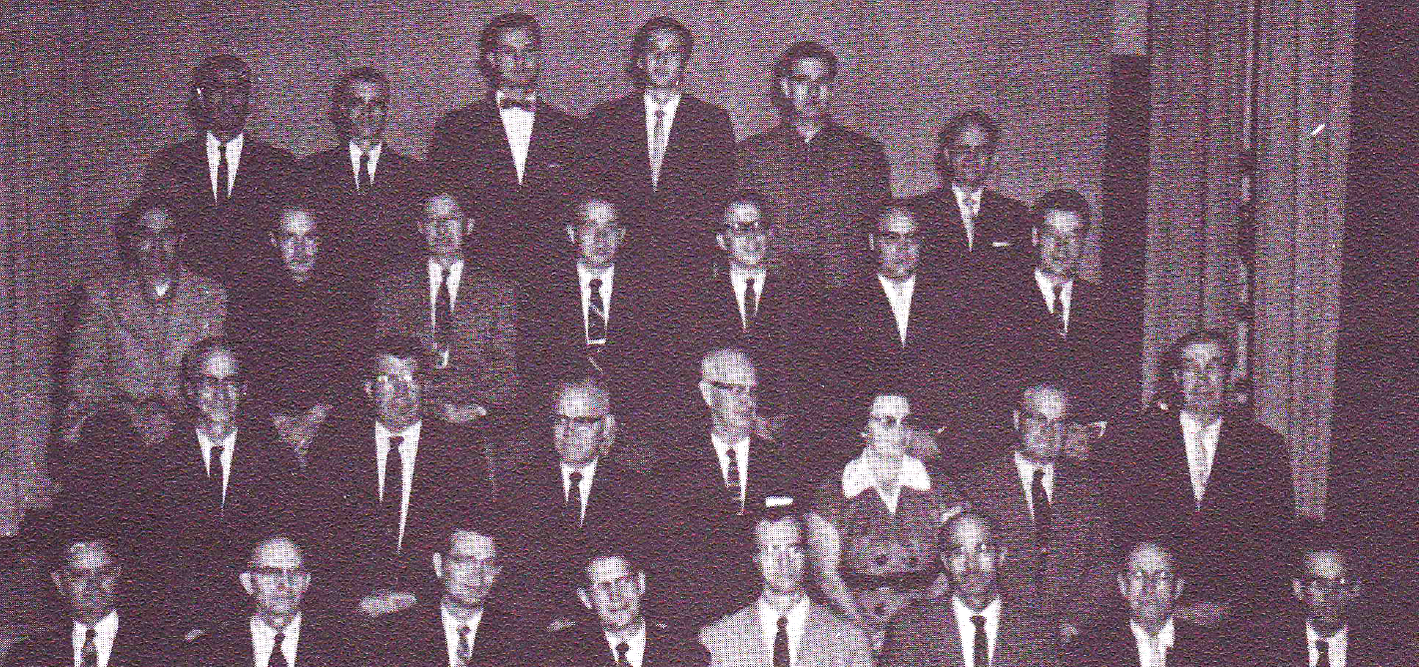
FRONT ROW L-R: Ferdinand Billeter, Heber Christensen, Bruce Eyre, Paul Gines, Paul Wood, Rodney Waller, Floyd Underwood, Frank Monk. SECOND ROW: John White, Alton Fisher, Grant Morgan, Frank Stone, Florence Averill, Alfred Keeley, George Peerce. THIRD ROW: Eugene Plumby, Peter Green, Bernard Davidson, Jerry Westberg, Leon Curtis, Lawrence Anderson, Verl Thorup. BACK ROW: Julian Ortiz, Leon Edwards, Jerry Schwab, Jay Christensen, Clarence Burton, Wayne, Stewart. NOT lN PICTURE: Earl Smith, Ralph Glenn, Edna Glenn, John Streel, Peggy Street, Don North, Thelma North, LeVell Olsen, John Palmer, Ottrie Palmer, Robert Welsh, John Hancock, Joy Hancock, Elaine Smith, Richard Burbaker
According to Rodney W. Walker's report in 1966, NFSD was one of the top fifteen life insurance companies in the United States. It excelled in assets per $100 of liabilities, surplus for $100 of insurance, and interest earned rate. Additionally, it had the lowest death rate among its competitors. The original Fraternal Society of the Deaf had 90 members and $279.94 in the bank when it held its first convention in Chicago in 1903. The society reorganized and had $5.5 million in assets by its 65th anniversary in 1966. Its membership had grown to approximately 10,000 people. Furthermore, the society paid more than $1,490,400 in death and disability benefits to its members and beneficiaries, totaling $8,281,500. These are impressive achievements for the organization over six decades (Walker, 1966).

Robert G. Sanderson and his wife, Mary M. Antonietti, have broken into big smiles for Utah's local cameraman Keith Nelson at the banquet of the Salt Lake Division of the NFSD. Bob Sanderson, UAD's past president and a recent and current NAD board member, has been nominated by the Utah Association to cooperate with the president of the National Association of Deaf (The Silent Worker, March 1964)
Salt Lake City Division No. 56
Celebrates its 50th Anniversary
Celebrates its 50th Anniversary
Salt Lake City Division No. 56 celebrated its 50th anniversary on October 15, 1966, with a gala at the historic Prudential Savings building on 33rd South and State Street. The celebration featured a banquet, a floor show, door prizes, and a souvenir program. Rodney W. Walker led the party committee, which included former officers Peter M. Green, Paul D. Wood, Veri W. Thorup, G. Lynn Losee, Norman B. Williams, and John F. White. Alfred C. Keeley was the only original division member present. The guest speaker was Leonard B. Warshawsky, assistant grand secretary-treasurer of the NFSD Home Office in Chicago, Illinois. Brigham Young University dancers performed at the event. The souvenir program included historical photographs of members dating back to the society's inception, as well as a list of members from its inception through its 50th anniversary.
In 1980, the NFSD Home Office recognized Salt Lake Division No. 56 as "Division of the Year." The NFSD Home Office praised the division for its good fraternal spirit, participation in community activities, high meeting attendance, and recruitment of new members. At the time, there were over 150 divisions in the United States and Canada, making selection for this honor a significant achievement (UAD Bulletin, Summer 1966; UAD Bulletin, Winter 1967; Walker, 2006).
In 1980, the NFSD Home Office recognized Salt Lake Division No. 56 as "Division of the Year." The NFSD Home Office praised the division for its good fraternal spirit, participation in community activities, high meeting attendance, and recruitment of new members. At the time, there were over 150 divisions in the United States and Canada, making selection for this honor a significant achievement (UAD Bulletin, Summer 1966; UAD Bulletin, Winter 1967; Walker, 2006).

Golden Jubilee Committee for the Salt Lake City Division No 56 of the National Fraternal Society of the Deaf’s 50th Year Anniversary, 1966.
Front Row (L-R): Ex-Office Peter M. Green, Chairman Rodney W. Walker, Paul D. Wood. Back Row (L-R): Verl W. Thorup, G. Lynn Losee, Norman B. Williams, and John F. White

Members of the Salt Lake City Division No. 56,, 1966, FRONT ROW: (left to righ+| Walter Wilson, Frank Monk, Roberl Bonnell, Paul Wood, Al{red Keeley, Peier Green, Bruce Eyre, LaVell Olsen, John White. MIDDLE ROW: Olirie Palmer, Thelma No*h, Mauna Wilson, Florence Averill, Elaine Smiih, Leon Edwards, Heber
Chrisfensen, Ferdinand Billeter, Boyd Collins, Floyd Underwood, Keith Stewart. BACK ROW: Donald North, Norman Williams, Clarence
Burlon, Roy Cochran, Von Jones, Lynn Losee, Earl Smith, Rodney Walker. N OT lN PCT U R E: Lawrence Anderson, Lawrence Christensen, Sleven Chrisiensen, Paul Gines, Raplh Glenn, Edna Glenn, George Milburn, Grant Morgan, John Palmer, John Sfreel, Wayne Stewart, Jerry Westberg, Verl Thorup, Eugene Plumby, Lee Shepherd, Madelaine Burlon
The Establishment of the
Ogden Division No. 69
Ogden Division No. 69
Melville J. Matheis, the State Organizer, assisted a group of individuals in establishing their local division in Ogden, Utah on November 9, 1918. The founding members of Ogden Division No. 69 were Nephi Larsen, Otto Farley, William Vaughn, and Alfred D. Young. Unfortunately, the division's existence was short-lived, and it was dissolved on December 1, 1923 (Walker, 1966; UAD Bulletin, April 2002).
The National Fraternal Society of the Deaf
Saves the Farley Family
Saves the Farley Family
Otto Paul Farley was a well-known and brilliant Deaf man who worked as a printer at the Utah School for the Deaf. He served in various positions at the National Fraternal Society of the Deaf. Sadly, he died on November 12, 1920, at the young age of 30. At his funeral, the Ogden Division of the NFSD placed the word "Brothers" on a large crescent and set a pedestal with the initials "NFSD" on the base to honor him (White, The Silent Worker, December 1920). Otto's wife, Pearl West Farley, and their infant son, Owen Theodore, survived him. Pearl experienced immense grief when their daughter, Nellie Virginia, died in early June (White, The Silent Worker, December 1920). She suddenly found herself in a desperate situation. Fortunately, Pearl received a check for $1050 from the NFSD the day after Christmas. This payment process was possible because her spouse was a member of NFSD, and after only four years of paying a few dollars in dues, the society covered necessities like food, clothing, and housing for her (The Silent Worker, December 1920; White, The Silent Worker, February 5, 1921).
President Harry C. Anderson,
of the National Fraternal Society of the Deaf,
Visits Ogden, Utah
of the National Fraternal Society of the Deaf,
Visits Ogden, Utah
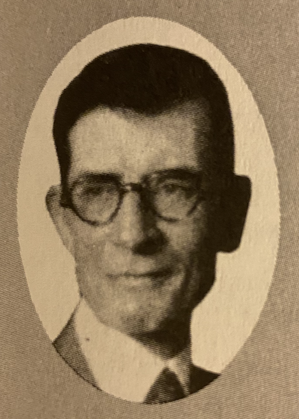 Harry C. Anderson. Gannon, 1981
Harry C. Anderson. Gannon, 1981
During his visit to Idaho in the 1920s, Harry Sanger Smith, a writer for The Silent Worker magazine, a Deaf publication, and a printing and linotyping instructor at the Utah School for the Deaf, learned that the president of the National Association of the Deaf Harry C. Anderson was planning to visit Ogden, Utah. Harry decided on an unusual way of greeting President Anderson during his first visit to Utah. He noted that rail travel attracted people who had never traveled much. Even though President Anderson had never met a person from Utah before, Harry recognized him at the railway station, which he described as "a really simple thing." After the formal introduction, Harry's friend, Paul Mark, "roped and tied" President Anderson and tossed him into his Peerless car. They then traveled through Ogden Canyon to the Heritage Hotel, where President Anderson and his wife stayed. "Riding through the canyon was a revelation to President Anderson," Harry joyfully shared. He had never seen the Rocky Mountains before, and the call of the wild was strong in him. "President Anderson took tremendous joy in the picturesque and the beautiful, just as old Mother Nature made things; the mountains and the prairies appealed to him more than all the swell affairs ever given in his honor," Harry remarked. (White, The Silent Worker, November 1920).
The Establishment of the
Ogden Division No. 127
Ogden Division No. 127
According to Walker (1966), in June 1945, the Ogden Division rechartered as Ogden Division No. 127, transferring twenty-two members from the Salt Lake City Division No. 56. The society's Home Office nominated Brother George L. Laramie to preside over the Ogden Division's first meeting and install new officers. The officers were Donald L. Jensen, Robert J. Welch, Ned C. Wheeler, Wayne H. Christensen, John C. Peterson, Roy E. Smith, Arvel Christensen, Kenneth C. Burdett, Lloyd H. Perkins, Paul Mark, Joseph B. Burnett, Paul Loveland, Pete Koukoutaskis, Bruce M. Eyre, Guy A. Despain, Merrill Bauer, Melwin Sorensen, Tony Jelaco, and Marlo Honey.
The Ogden Division No. 127 celebrated its 20th anniversary in December 1965, with a membership that was still vibrant in both numbers and spirit (Walker, 1966).
The Ogden Division No. 127 celebrated its 20th anniversary in December 1965, with a membership that was still vibrant in both numbers and spirit (Walker, 1966).

Members of the Ogden Division No. 127, 1965. Front Row (L-R): Robert Sanderson, Joseph Bunnett, Ned Wheeler, Avel Christensen. Middle Row (L-R): Ray Smith, Mary Sanderson, Edith Wheeler, Dorothy Linden, Joe Kerschbaum. Back Row (L-R): Oliver Woodward, Charles Buck, Chrles Whipple, Leon Curtis, Donald Jensen, Kenneth Burdett, Jack Peterson, Richard Brubaker, Harry Woffe, and Jerry Taylor
The Ogden Division No. 127
Celebrates its 25th Anniversary
Celebrates its 25th Anniversary
The Ogden Division No. 127 celebrated its 25th anniversary on July 11, 1970. Around 100 individuals from the NFSD's Salt Lake and Ogden divisions gathered in the ballroom of the Ben Lomond Hotel to commemorate the occasion. Grand division president Frank B. Sullivan spoke about the remarkable growth of the Deaf community, the various organizations that have served them over the previous decade, and future advancements. Salt Lake division president Keith Stewart presented Ogden division president Edith Wheeler with a $25.00 check to commemorate the division's 25th anniversary. LaVern Burnett's "The Impossible Dream" and Jerry Taylor's "The Star-Spangled Banner" were magnificent sign songs. Robert G. Sanderson acted as the banquet's master of ceremonies, while Grand Western Vice President Ned C. Wheeler delivered remarks. The success of the evening was attributed to Joseph Burnett and his wife, LaVern Burnett (UAD Bulletin, Fall-Winter 1970–71).

Edith Wheeler, President of Ogden Division No 127, and wife of Western Grand Vice President, Ned Wheeler, expressed her appreciation for the $25.00 gift given Division 127 by Salt Lake Division No. 56 and presented Keith Stewart (standing behind Edith), president of the Salt Lake Division. Occasion was the 25th Anniversary celebration of the Ogden Division. Looking on, left to right are: Frank Sullivan, Grand President, guest speaker, emcee Robert Sanderson, Mary Sanderson and Kenneth Burdett, first president of the Ogden Division. Source: The Frat, 1970
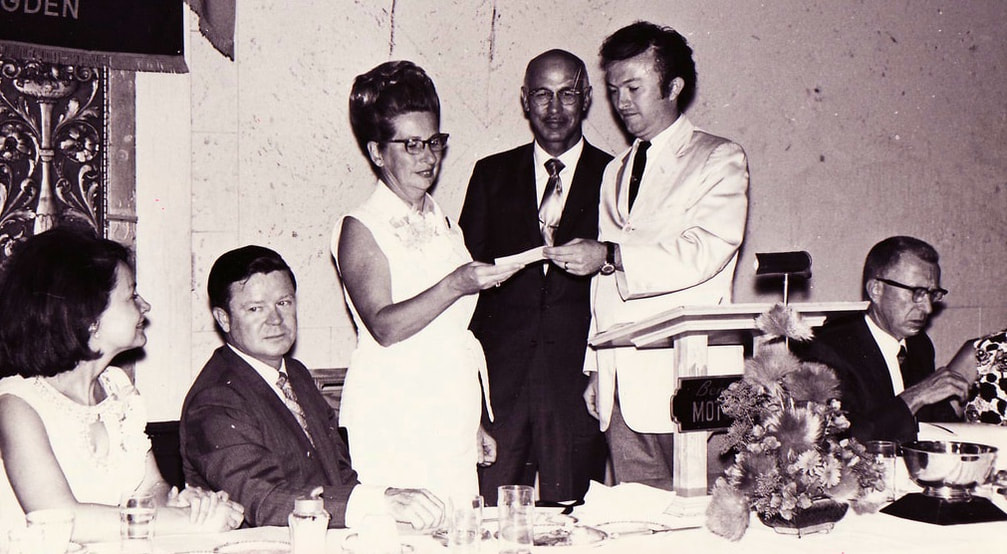
Edith Wheeler, President of Ogden Division No 127, and wife of Western Grand Vice President, Ned Wheeler, expressed her appreciation for the $25.00 gift given Division 127 by Salt Lake Division No. 56 and presented Keith Stewart, president of the Salt Lake Division. Occasion was the 25th Anniversary celebration of the Ogden Division. Looking on, left to right are: Frank Sullivan, Grand President, guest speaker, emcee Robert Sanderson. Behind Edith and Keith is Rodney Walker
The Ogden Division No. 127 Hosts the Christmas Frat Banquet on December 5th, 1970
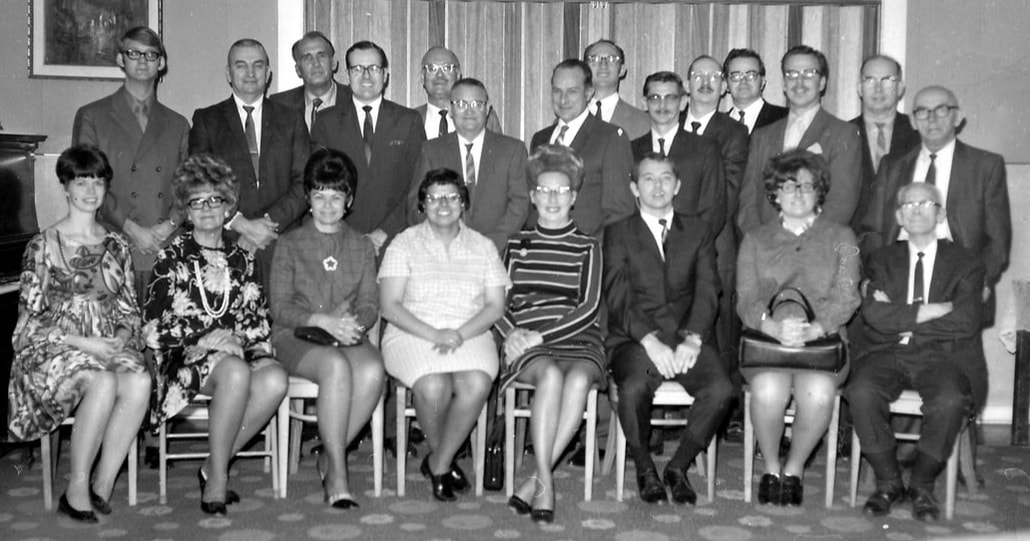
Members of the Ogden Division No. 127. Bottom Front L-R: Valarie Kinney Platt, LaVern Burnett, Mary Sanderson, Nellie Sausedo, Edith Wheeler, Dennis Platt, Karen Schultz, Charles Whipple (?) Top L-R: Bruce VanKamper, Roy Smith, Joseph Burnett, Kenneth Kinner, Kenneth Burdett, Arvel Christiansen, Ned Wheeler, Max Hardy, Jerry Taylor, Richard Brubaker, Keith Nelson. Leon Curtis, Jack Peterson, Joe Kerschbaum (?)
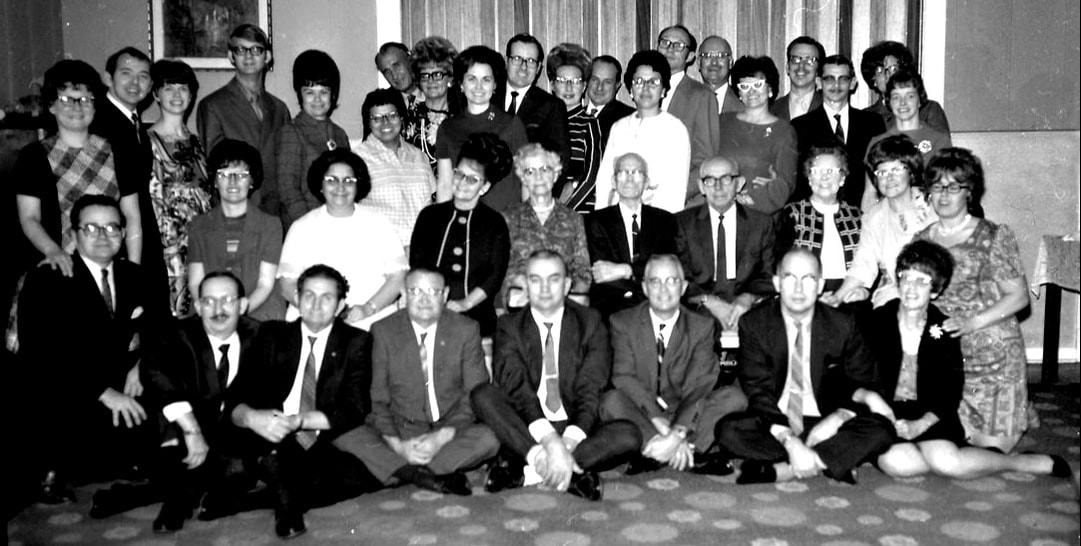
Members of the Ogden Division No. 127. Bottom Row L-R: Richard Brubaker, _____, Arvel Christensen (?), ____, Roy Smith, ____, Jack Peterson, _____ Second Row L-R: Keith Nelson, Joan Brubaker, Ruth Smith, Farn Woodward, ___, ____, ____, ____, Margaret (?), Cleo PetersonTop Row L-R: Jean Nelson, Dennis Platt, Valerie Kinney Platt, Bruce VanKamper, Mary Sanderson, Nellie Sausedo, Joseph Burnett, LaVern Burnett, Ilene Kinner, Kenneth Kinner, Edith Wheeler, Ned Wheeler, Evenlyn Hardy, Max Hardy, Kenneth Burdett, Priscilla Burdett, Leon Curtis, Jerry Taylor, Nancy Taylor, ___ (back)
The Utah Frats Celebrate NFSD's 75th Anniversary
with a Picnic on June 12, 1976
with a Picnic on June 12, 1976
The Salt Lake City Division No. 56
Celebrates Its 75th Anniversary
Celebrates Its 75th Anniversary
In 1991, the Salt Lake City Division No. 56 of the National Fraternal Society of the Deaf celebrated its 75th anniversary. However, the number of members has significantly decreased since its peak. To commemorate the occasion, members of the Ogden Division No. 127 joined hands with the Salt Lake City division to organize a grand banquet. To show appreciation, the Home Office presented a plaque, which read, "NATIONAL FRATERNAL SOCIETY OF THE DEAF—SALT LAKE CITY DIV. #56—For 75 YEARS OF FRATERNAL SERVICE—October 24, 1991." The banquet also honored John F. White, the longest-serving member of the division, who has been a member for 58 years since joining in 1935. Additionally, Rodney W. Walker was recognized for his 51 years of service to the organization (Walker, 2006).
The Salt Lake City Division No. 56 and the Ogden Division No. 127 Host the 27th Quadrennial Convention
During the 1991 NFSD meeting held in Milwaukee, Wisconsin, there was fierce competition among the delegations to determine the next host city of the 1995 NFSD convention. Nancy and Jerry Taylor, representing the Utah delegation, along with Robert and Mary Sanderson from Ogden Division No. 127, secured the honor of hosting the convention in Salt Lake City. Peter M. Green from Salt Lake City Division No. 56 did an excellent job promoting his team. Pete and Nancy dressed up as honeybees in a buzzing skit to market Utah as "the place to bee" and bring one's beehive along for a lovely meeting and a family vacation. They collaborated on a unique presentation featuring neon bee-themed flyers distributed to all eighty-one delegates and salt-water taffy. Additionally, the two divisions held a hospitality room with the cooperation of Kathy Schell of the Little America Hotel, generating positive feedback from attendees who found the Utah people remarkable (Sanderson, Utah Bulletin, August 1991).
In 1991, there were several divisions vying to host the 1995 convention. Among these were Washington, D.C., Miami-Fort Lauderdale in Florida, and Tucson in Arizona. During the bidding process, both Florida and Arizona had hospitality rooms and made presentations, but Utah emerged as the winner with the most votes. Following this, the two divisions formed a committee to plan the 1995 convention (Sanderson, Utah Bulletin, August 1991).
In July 1995, the National Fraternal Society of the Deaf held its 27th Quadrennial Convention in Salt Lake City. Salt Lake City Division No. 56 and Ogden Division No. 127 organized the event after almost four years of planning. Peter M. Green chaired the convention, where Dr. Frank B. Sullivan, a nationally recognized speaker, delivered the keynote address at the Friday evening banquet. Dr. Sullivan, who was a former Grand President of the National Federation of the Deaf and a consultant for the National Captioning Institute, had graduated from the Montana School for the Deaf in 1936. During the banquet, Bill Carwile, a well-known mime, provided entertainment with his pantomime (UAD Bulletin, July 1995).
Many important events took place during this time, including golfing, watching the Pioneer Days Parade, taking a bus tour to Wendover, Utah, board meetings, workshops, the President's Reception, a Hall of Fame luncheon, business meetings, a fun night, a Gallaudet University continental breakfast, a banquet and awards night, a picnic buffet, and entertainment (Walker, 2006). On one of the evenings, a professional entertainer named Mary Beth Miller from New York made many people laugh (UAD Bulletin, July 1995).
At that time, various organizations were available to Deaf men, such as insurance, education, recreation, business, jobs, and membership organizations, which were unavailable a century ago. However, the need for a say in one's advancement, welfare, and socialization has been constant throughout history (Walker, 2009, p. 170–171).
At that time, various organizations were available to Deaf men, such as insurance, education, recreation, business, jobs, and membership organizations, which were unavailable a century ago. However, the need for a say in one's advancement, welfare, and socialization has been constant throughout history (Walker, 2009, p. 170–171).
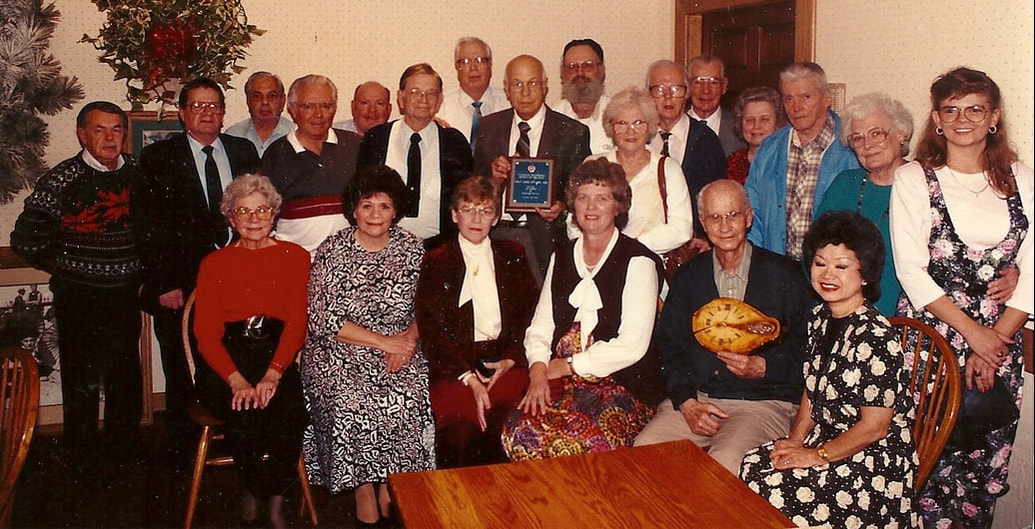
Standing (L-R): Peter Green, George Gavros, Eugene Plumby, Lee Shepherd, Boyd Collins, Bruce Eyre, Robert Bonnell, Rodney Walker, Jerry Schwab, Ottrie, Schwab, Paul Wood, Verl Thorup, Carol Addeman, Spencer Addeman, Vida White, Penny Williams. Sitting (L-R): LaRue Ross, Carole Gavros, Darlene Bonnell, Dorothy Young, Jack White, and Sally Green
The 1995 convention program featured the
Society's core philosophy,
as outlined in the section below
Society's core philosophy,
as outlined in the section below
FRATERNALISM. Let us carry that message forward into the next century, telling other people that what we offer is much more than just a policy certificate. We care about each other; we really care (127th Quadrennial Convention Program Book, 1995).
Did You Know?
The 34th-degree designation was awarded by the National Fraternal Society of the Deaf to Dr. Robert G. Sanderson of the Ogden Division No. 127. The NFSD gave this designation to members who had contributed, demonstrated dedication to the causes, and exemplified the spirit of fraternalism (UAD Bulletin, September 1995).
Over time, some members of Salt Lake Division No. 56 started missing meetings, while many quit and others passed away. The meeting place for the division changed several times and eventually settled at the Robert G. Sanderson Community Center of the Deaf and Hard of Hearing in Taylorsville, Utah. According to Walker's (2006) estimates, Salt Lake City Division No. 56 had a total membership of approximately 310 between the division's charter and the end of 1997. The National Fraternal Society of the Deaf had its final convention in Lake Buena Vista, Florida, in 1999. Salt Lake City Division No. 56 elected Rodney W. Walker as its delegate, and he traveled to Lake Buena Vista, Florida, near Orlando, for the convention. Much of the convention focused on attracting and retaining members (Walker, 2006).
Did You Know?
The National Fraternal Society of the Deaf inducted Valerie G. Kinney into the Golden Circle in 2000. She has been a member of Ogden Division No. 127 since January 1970. Her 25 years of membership and continued service to the division and the Society beyond the 34th degree made her eligible for this honor. The Golden Circle was an exclusive recognition awarded to less than 1% of all Society members (UAD Bulletin, April 2000).
The National Fraternal Society of the Deaf
Celebrates Its 100th Birthday
Celebrates Its 100th Birthday
In 2001, the NFSD celebrated its 100th birthday in Chicago, with delegations from several divisions in attendance. However, no delegates were sent from Salt Lake City. The Home Office made an amendment to hold the quadrennial convention, adding the necessity of a mail-in ballot due to limited budgets (Walker, 2006). Regrettably, Salt Lake City Division No. 56's population had begun to decline, posing challenges in maintaining the necessary "quorum" for regular meetings. After 87 years of service, a quorum of five members disbanded the Salt Lake City Division No. 56 in July 2004 (Walker, 2006).
The Declination and Final Closure of the
National Fraternal Society of the Deaf
National Fraternal Society of the Deaf
The National Fraternal Society of the Deaf experienced a decline in membership for various reasons. Since the late 1980s, Deaf individuals have had access to different insurance options, leading life insurance companies to offer reduced-price policies to compete with one another. As a result, hearing parents with Deaf children purchased life insurance from companies other than the NFSD. Moreover, some Deaf individuals accumulated enough NFSD insurance to cash in on their life insurance policy. All of the issues mentioned above, along with others, contributed to the NFSD's downfall (Walker, 2006).
Thanks to the efforts of thirteen young men who founded the NFSD in 1898, Deaf individuals can now obtain insurance. In 2005, the Catholic Order of Foresters took over the NFSD's insurance business, intending to transform it into a fraternal society. However, two-thirds of the members did not renew their $25 annual membership fee. Without any other source of income, the NFSD could no longer maintain an office or provide membership perks. On January 1, 2007, the NFSD's Board of Directors decided to suspend operations and pass over its insurance business to the Catholic Order of Foresters. After 105 years, the NFSD had to close its doors (DeafWeekly, February 21, 2007). At the time of its termination, Jerry Taylor was the last president of the Ogden Division No. 127, and Willis Morton was the last president of the Salt Lake City Division No. 56.
Thanks to the efforts of thirteen young men who founded the NFSD in 1898, Deaf individuals can now obtain insurance. In 2005, the Catholic Order of Foresters took over the NFSD's insurance business, intending to transform it into a fraternal society. However, two-thirds of the members did not renew their $25 annual membership fee. Without any other source of income, the NFSD could no longer maintain an office or provide membership perks. On January 1, 2007, the NFSD's Board of Directors decided to suspend operations and pass over its insurance business to the Catholic Order of Foresters. After 105 years, the NFSD had to close its doors (DeafWeekly, February 21, 2007). At the time of its termination, Jerry Taylor was the last president of the Ogden Division No. 127, and Willis Morton was the last president of the Salt Lake City Division No. 56.
The National Fraternal Society of the Deaf is one of the oldest organizations for the Deaf in the United States. For more than a century, the NFSD has been offering insurance exclusively to the Deaf and hard of hearing community and their families. Thousands of Deaf individuals have benefited from the Society's insurance program since it was established in 1901. The NFSD has been successful in its business, ensuring that Deaf people no longer face difficulty obtaining insurance coverage. Despite facing intense competition from other insurance firms, the NFSD has remained financially stable. It was a great example of a determined group of Deaf individuals achieving success and eliminating discrimination. The NFSD also demonstrates that hearing loss does not have to be a barrier to business success (Gannon, 1980). However, it is unfortunate that the NFSD has closed down, as it was a valuable source of connection and support for the Deaf community facing challenges together in mainstream society.
National Fraternal Society of the Deaf
Hall of Fame
Hall of Fame
The Hall of Fame has inducted a number of NFSD Utahns, including
- 1973 – Paul Mark, Ogden Division No. 69
- 1974 – Ned C. Wheeler, Ogden Division No. 127
- 1975 – Kenneth C. Burdett, Ogden Division No. 127
- 1977 – Rodney W. Walker, Salt Lake Division No. 56
- 1978 – George L. Laramie, Salt Lake Division No. 56
- 1994 – Dr. Robert G. Sanderson, Ogden Division No. 127 and Peter Green, Salt Lake Division No. 56 (Gannon, 1981; Walker, 2006)
Did You know?
Peter M. Green became a member of the National Fraternal Society of the Deaf in 1951, and he was one of the four people inducted into the Hall of Fame in 1994. The selection was based on their contributions to their respective divisions and the broader community. The names of all those recognized over the years are listed on a permanent plaque at the home office. Pete joined the division at the age of 16 and has been an active member ever since. During the Society's 1991 convention in Milwaukee, Wisconsin, he and other fraternity members became delegates and successfully voted for the Salt Lake City Convention venue for 1995 (UAD Bulletin, September 1995).
Celia May Laramie Baldwin
Was Named "Frater of the Year"
Was Named "Frater of the Year"
In 1981, Celia May Laramie Baldwin of Salt Lake City No. 56 was named "Frater of the Year" (Gannon, 1981).
Division of the Year
In 1979, the Division No. 56 of Salt Lake City, Utah, was named "Division of the Year" (Gannon, 1981).
Dr. Robert G. Sanderson, Chairman of the National Fraternal Society of the Deaf
Board of Director
Board of Director
According to the 27th Convention Program Book, Dr. Robert G. Sanderson was elected as the first chairman of the NFSD Board of Directors in 1995. He served as chairman from 1983 until 1999 and was also a member of the Board of Directors from 1987 to 1991, per Borggaard (2001).
Ned C. Wheeler Serves, Western Vice-President
of the National Fraternal Society of the Deaf
Board of Director
of the National Fraternal Society of the Deaf
Board of Director
Ned C. Wheeler held the position of Western Vice-President from 1967 to 1981, after which Dr. Robert G. Sanderson took over his responsibilities from 1983 to 1987, following Wheeler's death in 1981 (Borggaard, 2001).
Dorothy Young of Utah Serves as the
National Fraternal Society of the Deaf Delegate
National Fraternal Society of the Deaf Delegate
Dorothy Young of Utah served as a delegate for Division No. 56 in Salt Lake City and Division No. 127 in Ogden (27th Quadrennial Convention Program Book, 1995).
ARCHIVES
The following historical materials about the National Fraternal Society of the Deaf have been digitized and uploaded to this webpage. Enjoy learning about the rich history of this organization!
- Golden Anniversary. Salt Lake City Division No. 56. National Fraternal Society of the Deaf. 1916-1966. Prudential Plaza Auditorium. October 15, 1966. (PDF)
- National Fraternal Society of the Deaf. 27th Quadrennial Convention. “This is the Place.” Salt Lake City. Little America Hotel. 24-29, 1995. (PDF)
NFSD Ogden Division #127 Newsletters
References
“After 105 years, Fraternal Society closes." DeafWeekly, Vol. 3, No. 12, February 21, 2007.
"Another Utahn Receives Award." UAD Bulletin, Vol. 19.4 (September 1995): 1.
Borggaard, Virginia C. Celebrating a Rich Heritage 1901 – 2001. 2001.
Gallaudet University Library Deaf Collections and Archives, " Records of National Fraternal Society of the Deaf, 1900-2006." http://www.gallaudet.edu/Library_Deaf_Collections_and_Archives/Collections/Manuscript_Collection/MSS_163.html
Gannon, Jack R. Deaf Heritage: A Narrative History of Deaf America. Silver Spring, Maryland: National Association of the Deaf, 1981.
"Golden Circle Gains New Member." UAD Bulletin, Vol. 23.11 (April 2000): 1.
Kinney, Valerie. "Utah Deaf Trivia." UAD Bulletin, Vol 25.11 (April 2002): 3.
National Fraternal Society of the Deaf: 27th Quadrennial Convention program book, July 25-29, 1995.
"National Fraternal Society of the Deaf: 27th Quadrennial Convention program book." UAD Bulletin, Vol. 19.2 (July 1995): 9 - 10.
"News From Ogden Frat Division #127.” UAD Bulletin, Vol. 6, No. 4 (Fall-Winter, 1970-71): 3.
Obituary. The Silent Worker, Vol. 37, No, 7, April 1925. http://dspace.wrlc.org/view/ImgViewer?url=http://dspace.wrlc.org/doc/manifest/2041/39603
"S.L. Frat Celebrates Golden Anniversary." UAD Bulletin, Vol. 4, No. 5 (Winter 1967): 7.
"Salt Lake Frat to Mark 50th Year." The UAD Bulletin, Vol. 4, No. 3 (Summer 1967): 1.
Sanderson, Robert . "Utah Wins 1194 NFSD Convention!" UAD Bulletin, Vol. 15, No. 3 (August 1991): 1.
"SWinging 'round the nation." The Silent Worker, vol. 16, no 7 (March 1964): 14.
"Utahn Honored at Frat Banquet." UAD Bulletin, Vol. 19.4 (September 1995): 1 & 7.
Walker, Rodney Wilson. "Salt Lake Frat to Celebrate 45th Anniversary." The UAD Bulletin, Vo1. 2, No. 4 (Fall 1961): 1 & 4.
Walker, Rodney Wilson. Outlined History of the National Fraternal Society of the Deaf. Golden Anniversary: Salt Lake City Division No. 56 National Fraternal Society of the Deaf 1916-1966. Prudential Plaza Auditorium, October 15, 1966.
Walker, Rodney Wilson. My Life Story, 2006.
White, Bob. "Notes and Comments from the Land of the Mormons." The Silent Worker, Vol. 32, No. 7, April 1920. http://dspace.wrlc.org/view/ImgViewer?url=http://dspace.wrlc.org/doc/manifest/2041/38096
White, Bob. “Winding Trails.” The Silent Worker, vol. 33, no. 2, November 1920. http://dspace.wrlc.org/view/ImgViewer?url=http://dspace.wrlc.org/doc/manifest/2041/38227
White, Bob. "A Tribute to Otto P. Farley." The Silent Worker, Vol. 33, No. 3, December 1920. http://dspace.wrlc.org/view/ImgViewer?url=http://dspace.wrlc.org/doc/manifest/2041/38247
White, Bob. "Going Some - and More." The Silent Worker, Vol. 33, No. 5, February 5, 1921. http://dspace.wrlc.org/view/ImgViewer?url=http://dspace.wrlc.org/doc/manifest/2041/38310
"Another Utahn Receives Award." UAD Bulletin, Vol. 19.4 (September 1995): 1.
Borggaard, Virginia C. Celebrating a Rich Heritage 1901 – 2001. 2001.
Gallaudet University Library Deaf Collections and Archives, " Records of National Fraternal Society of the Deaf, 1900-2006." http://www.gallaudet.edu/Library_Deaf_Collections_and_Archives/Collections/Manuscript_Collection/MSS_163.html
Gannon, Jack R. Deaf Heritage: A Narrative History of Deaf America. Silver Spring, Maryland: National Association of the Deaf, 1981.
"Golden Circle Gains New Member." UAD Bulletin, Vol. 23.11 (April 2000): 1.
Kinney, Valerie. "Utah Deaf Trivia." UAD Bulletin, Vol 25.11 (April 2002): 3.
National Fraternal Society of the Deaf: 27th Quadrennial Convention program book, July 25-29, 1995.
"National Fraternal Society of the Deaf: 27th Quadrennial Convention program book." UAD Bulletin, Vol. 19.2 (July 1995): 9 - 10.
"News From Ogden Frat Division #127.” UAD Bulletin, Vol. 6, No. 4 (Fall-Winter, 1970-71): 3.
Obituary. The Silent Worker, Vol. 37, No, 7, April 1925. http://dspace.wrlc.org/view/ImgViewer?url=http://dspace.wrlc.org/doc/manifest/2041/39603
"S.L. Frat Celebrates Golden Anniversary." UAD Bulletin, Vol. 4, No. 5 (Winter 1967): 7.
"Salt Lake Frat to Mark 50th Year." The UAD Bulletin, Vol. 4, No. 3 (Summer 1967): 1.
Sanderson, Robert . "Utah Wins 1194 NFSD Convention!" UAD Bulletin, Vol. 15, No. 3 (August 1991): 1.
"SWinging 'round the nation." The Silent Worker, vol. 16, no 7 (March 1964): 14.
"Utahn Honored at Frat Banquet." UAD Bulletin, Vol. 19.4 (September 1995): 1 & 7.
Walker, Rodney Wilson. "Salt Lake Frat to Celebrate 45th Anniversary." The UAD Bulletin, Vo1. 2, No. 4 (Fall 1961): 1 & 4.
Walker, Rodney Wilson. Outlined History of the National Fraternal Society of the Deaf. Golden Anniversary: Salt Lake City Division No. 56 National Fraternal Society of the Deaf 1916-1966. Prudential Plaza Auditorium, October 15, 1966.
Walker, Rodney Wilson. My Life Story, 2006.
White, Bob. "Notes and Comments from the Land of the Mormons." The Silent Worker, Vol. 32, No. 7, April 1920. http://dspace.wrlc.org/view/ImgViewer?url=http://dspace.wrlc.org/doc/manifest/2041/38096
White, Bob. “Winding Trails.” The Silent Worker, vol. 33, no. 2, November 1920. http://dspace.wrlc.org/view/ImgViewer?url=http://dspace.wrlc.org/doc/manifest/2041/38227
White, Bob. "A Tribute to Otto P. Farley." The Silent Worker, Vol. 33, No. 3, December 1920. http://dspace.wrlc.org/view/ImgViewer?url=http://dspace.wrlc.org/doc/manifest/2041/38247
White, Bob. "Going Some - and More." The Silent Worker, Vol. 33, No. 5, February 5, 1921. http://dspace.wrlc.org/view/ImgViewer?url=http://dspace.wrlc.org/doc/manifest/2041/38310
